Accounts Payables section.
Purchase Order section.
To create a new Purchase Order, select the "Enter New Purchase Order" option. The following screen will appear:

When entering a new Purchase Order, you are presented with the following options:
- Order #
Next available Purchase Order Number will automatically display, unless your system requires you to enter Purchase Order Numbers manually. Default values and input parameters for Purchase Order Numbers are configurable at the system level.
- Order Date
Displays current day's date.
- Status
The Purchase Order status will display here.
- Terms
Specify the billing Terms for the Order. Default billing Terms for a Vendor are defined on the Vendor master. You may select alternate Terms on the Purchase Order header.
- Tax Zone
Specify the Tax Zone associated with the Purchase Order. By default, the Tax Zone associated with the Vendor will be used.
- Receiving Site
Specify the Site where materials from the Purchase Order will be received. By default, all active Sites are available for selection as Receiving Sites. No special designation needs to be made in the Site master or elsewhere to indicate that a Site may be used for receiving purposes.
Tip
The receiving Site may differ from the supplying Site(s) for some Purchase Order Line Items. To update your Inventory records to indicate that Items have been moved from the receiving to the supplied from Site, perform an Inter-Site Transfer.
- Purchasing Agent
Specify the name of the agent assigned to the Order. By default, the name of the logged-in user will be entered as Purchasing Agent—assuming that user is designated as a Purchasing Agent. If the user is not a Purchasing Agent, the first alphabetical name in the list of Purchasing Agents will be entered.
- Print on Save
Check Print on Save to automatically print the Purchase Order when the Save button is pressed. If the Vendor specified on the Purchase Order has an EDI Profile attached, you may encounter an EDI processing interface when printing the Purchase Order.
- Vendor #
Enter the Vendor number of the Vendor you are issuing the Purchase Order to.
Note
A valid Vendor number must be entered in the "Vendor #" field before Line Items can be added to the Purchase Order. If no valid Vendor number is entered, you will not be able to add Line Items to the Purchase Order.
- Main Address
Displays the main address for the specified Vendor. The main address information is the primary Vendor address stored on the Vendor master.
- Alt. Address
Enter the number of an alternate Address. By default, the alternate Address will be used as the Ship-To Address when the Purchase Order is printed.
- F.O.B.
Enter the Free On Board (F.O.B.) location for the shipping Site.
- Ship Via
Enter the preferred Ship Via method for this Vendor. By default, the Ship Via entered on the Vendor master will populate this field.
To the far right of the screen, the following buttons are available:
- SAVE
Creates the new Purchase Order and saves the Purchase Order information. If your system is configured to prompt for printing on SAVE, then you will be presented with additional processing options after this button is selected.
- CANCEL
Closes the screen without creating a new Purchase Order, returning you to the application desktop.
To create or modify Purchase Order Line Items, select the "Line Items" tab at the top of the "Purchase Order" screen. The following screen will appear:
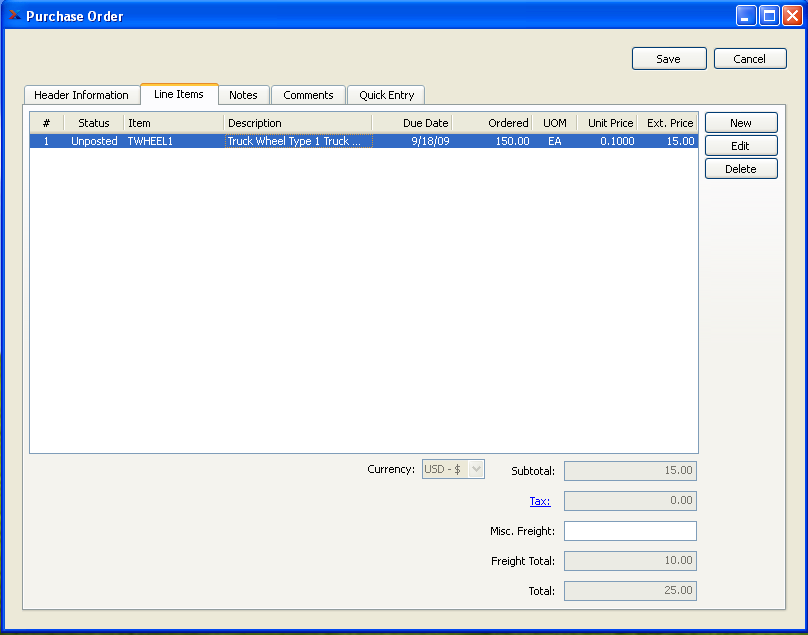
When creating or modifying Purchase Order Line Items, you are presented with the following options:
- Line Items
Display lists Line Items for this Purchase Order. A valid Vendor number must be entered in the "Vendor #" field before Line Items can be added to the Order.
- Subtotal
Displays the subtotal for the Purchase Order Line Items.
- Tax
Displays the calculated Tax amount, if applicable.
- Misc. Freight
Enter the amount of any miscellaneous freight charges to be added to the Order.
- Freight
Displays the total amount of freight charges. The amount displayed includes the sum of all Line Item freight and miscellaneous freight charges.
- Total
Displays the total value of the Purchase Order.
To the far right of the screen, the following buttons are available:
- SAVE
Saves the Purchase Order Line Item information.
- CANCEL
Closes the screen without creating a new Purchase Order, returning you to the application desktop.
- NEW
Opens screen for creating a new Purchase Order Line Item.
- EDIT
Enables you to edit highlighted Purchase Order Line Items. The edit screen is the same as that for creating a new Purchase Order Line Item—except that when editing, the fields will contain Purchase Order Line Item information. Double-clicking on a Purchase Order Line Item will also bring you to the editing screen.
- DELETE
Highlight a Purchase Order Line Item and then select this button to remove the Purchase Order Line Item from the list.
To add Notes to a Purchase Order, select the "Notes" tab at the top of the "Purchase Order" screen. The following screen will appear:
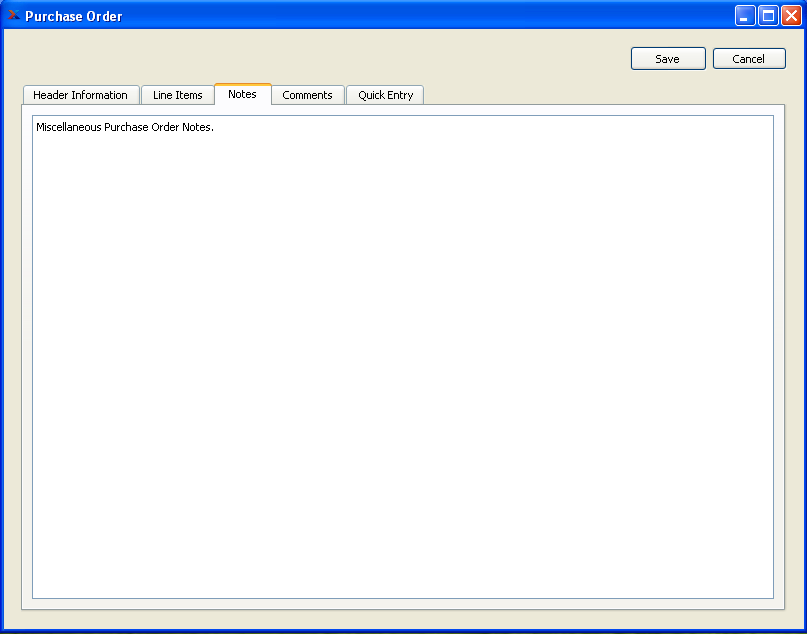
When adding Notes to a Purchase Order, you are presented with the following options:
- Notes
This is a scrolling text field with word-wrapping for entering Notes related to the Purchase Order.
To add Comments to a Purchase Order—or to view system-generated Comments—select the "Comments" tab at the top of the "Purchase Order" screen. The following screen will appear:

When adding or reviewing Comments, you are presented with the following options:
- Verbose Text
Select to display all Comments in the list in an expanded view which includes the entire text of each Comment. To edit a Comment, simply select the "Edit" link next to the Comment. That link will not be shown for Changelog Comments, which can't be edited. If the "Verbose Text" option is not selected, the Comment list will display only header level information for each Comment.
- Comments
Display lists Comments related to the record.
To the far right of the screen, the following buttons are available:
- NEW
Opens screen for creating a new Comment.
- VIEW
Highlight a Comment and then select this button to reach a read-only view of the "Edit" screen.
- EDIT
Enables you to edit highlighted Comments—as long as the Comments are not "ChangeLog" Comments. ChangeLog Comments are system-generated and may not be edited. The edit screen is the same as that for creating a new Comment—except that when editing, the fields will contain Comment information. Double-clicking on a Comment will also bring you to the editing screen.
To enter a new Comment, select the NEW button. The following screen will appear:

- Comment Type
Select a Comment Type from the drop-down list to classify the Comment. This is a required step. Comment Types may be system-defined (i.e., "ChangeLog" and "General") or user-defined, as described in Section 13.13, “Comment Types”. Once you have specified a Comment Type, begin typing your Comment in the main text area. The text area features word-wrapping and scroll-bar support for longer Comments.
To the far right of the screen, the following buttons are available:
- CANCEL
Closes the screen without creating the Comment, returning you to the previous screen.
- SAVE
Creates the Comment and adds it to the list of Comments.
- SHOW MORE
Select to show the complete list (i.e., "thread") of Comments associated with the record. To hide the list, simply select the SHOW MORE button again. The Comment thread will show the most recent Comment first.
If you want to speed up your data entry of Purchase Order Line Items, you can use the Quick Entry interface. This screen allows you to enter multiple Line Items in one session. It also simplifies the process by presenting only the minimum required fields. To enter Line Items using the Quick Entry interface, select the "Quick Entry" tab at the top of the "Purchase Order" screen. The following screen will appear:
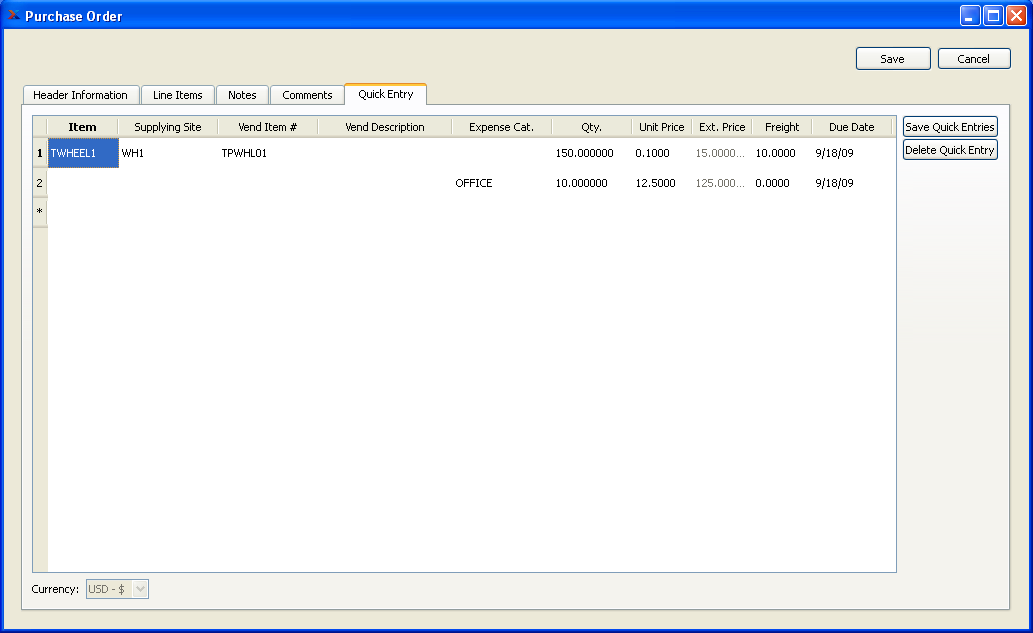
Tip
To get started entering Line Items, place your cursor in the "Item" field. You can then move from field-to-field using the TAB button on your keyboard.
When entering Purchase Order Line Items using the Quick Entry interface, you are presented with the following options:
- Item
Enter an Inventory Item Number. This field is used for entering Items stored in Inventory. Use the "Vend. Item #" field for entering non-Inventory Items.
- Supplying Site
Select a Supplying Site from the list of available options. By default, the user's preferred Site will be presented first.
- Vend. Item #
Use this field for entering non-Inventory Item Numbers. If not used to handle non-Inventory Items, this field will display Vendor Item Numbers for Inventory Items which have Item Sources defined.
- Vend Description
Enter the Vendor Description for the Item being ordered.
- Expense Cat.
Enter the Expense Category you want your non-Inventory quantity to be assigned to. Use this option for non-Inventory Line Items only.
- Qty.
Enter the quantity you want to purchase.
- Unit Price
Enter the Unit Price for the Line Item. If an Item Source is defined, this information may fill in automatically.
- Ext. Price
Displays the Extended Price. This is a calculated field and is shaded to indicate that it may not be edited.
- Freight
Enter the Freight amount, if any.
- Due Date
Enter the due date. If an Item Source is defined, this information may fill in automatically.
To the far right of the screen, the following buttons are available:
- SAVE QUICK ENTRIES
Select to save all the Line Items entered using the Quick Entry interface.
- DELETE QUICK ENTRY
Highlight a Line Item and then select this button to remove the Item from the list.
To create a new Purchase Order Line Item, select the NEW button. The following screen will appear:

When creating a new Purchase Order Line Item, you are presented with the following options:
- P/O Number
Displays the Purchase Order Number specified in the "New Purchase Order" screen.
- Line #
The application automatically assigns line numbers to Purchase Order Line Items. Numbering begins at one ("1") and increases automatically in increments of one.
- Inventory Item
If the Item being purchased is an Inventory Item, select this option and specify the following:
- Item Number
Enter the Item Number of the Item you want to add to the Purchase Order. You may also enter manufactured Items that you normally make, but you occasionally buy.
- Supplying Site
Specify the Site the Item will be supplied from. The supplying Site is the Site that supplies the Item in question to the shipping Site for shipment to Customers. Sites may be designated as supplying Sites in the Item Site definition.
Tip
The supplying Site may differ from the receiving Site(s) for some Purchase Order Line Items. To update your Inventory records to indicate that Items have been moved from the receiving to the supplied from Site, perform an Inter-Site Transfer.
- Non-Inventory Item
If the Item being purchased is a non-Inventory Item, select this option and specify the following:
- Expense Category
Select an Expense Category to assign the non-Inventory Item to.
- Qty. Ordered
Enter the quantity of the specified Item to be ordered.
- Qty. Received
Displays quantity received from quantity ordered.
- UOM
Unit of Measure Item is being ordered in.
- Tax Type
Select a Tax Type.
- Unit Price
Enter the Unit Price for the specified Item―or use the browse button to look up pricing information, including pricing related to quantity breaks.
- Extended Price
Displays the Extended Price. The Extended Price for a Line Item is based on the quantity ordered multiplied by the Unit Price.
Note
The option to associate a Project with a Purchase Order Line Item will only be visible if your site is configured to use Projects.
- Line Item Freight
Enter the amount of freight charges for the entire Line Item quantity. The system automatically calculates the per unit freight charge by dividing the Line Item freight amount by the Line Item quantity. This per unit freight charge is needed when receiving or vouchering quantities less than the original quantity ordered. Line Item freight is distinguished from miscellaneous freight, which applies to the Purchase Order as a whole
- Tax
Displays the calculated tax amount.
- Due Date
Specify date when Order is expected to be received.
- Project #
Select a Project Number to associate with the Purchase Order Line Item. If the Purchase Order Line Item is being created from a Purchase Request driven by Sales Order demand—and the parent Sales Order had a Project Number associated with it—then the Project Number from the parent Sales Order will automatically be entered here. In this way, Sales Orders and Purchase Order Line Items may be linked to the same Project.
- Vendor Source Information
If Item Source information exists for an Inventory Item, that information will display automatically here. For non-Inventory Items, you should specify an Item Number and Item description.
- Vend. Item Number
Enter the Item number the Vendor assigns to the specified Item.
- Vendor Item Description
Enter the description the Vendor uses to describe to the specified Item.
- Min. Order Qty
For Inventory Items only, displays the minimum order quantity for the specified Item and the specified Vendor. Minimum order quantities are established in the Item Source master.
- Order Qty. Mult.
For Inventory Items only, displays the order multiple for the specified Item and the specified Vendor. Order multiples are established in the Item Source master.
- Vendor UOM:
For Inventory Items only, displays the Unit of Measure used by the Vendor for the specified Item.
- Inv./Vendor UOM Ratio:
For Inventory Items only, displays the ratio between Inventory and Vendor Units of Measure.
Note
The Inv./Vendor UOM Ratio specifies the ratio between Inventory and Vendor Units of Measure (UOM). For example, if you store an Item in single units, but a Vendor sells you the Item in cases of 12, then the ratio would be 12—or 12:1. When an Inv./Vend. ratio is specified, the system allows you to purchase Items using the Vendor's UOM; however, when the Items are received, the system will automatically convert the Inventory to your Inventory UOM.
- Earliest Avail. Due Date
For Inventory Items only, displays the earliest due date for the specified Item.
To the far right of the screen, the following buttons are available:
- SAVE
Creates the new Purchase Order Line Item and adds it to the list of Purchase Order Line Items.
- CANCEL
Closes the screen without creating a new Purchase Order Line Item, returning you to the application desktop.
To add manufacturer information to the Purchase Order Item, select the "Manufacturer" tab. The following screen will appear:
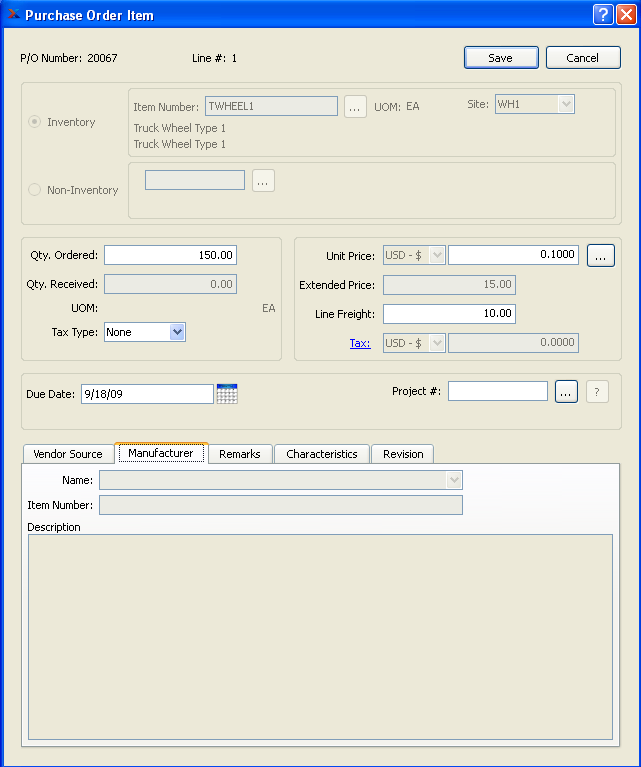
When entering manufacturer information to a Purchase Order Item, you are presented with the following options:
- Name
The name of the manufacturer who creates the Item.
- Item Number
The Item Number the manufacturer uses to identify the component.
- Description
The Description the manufacturer uses to describe the item.
To add miscellaneous Remarks to the Purchase Order Item, select the "Remarks" tab. The following screen will appear:
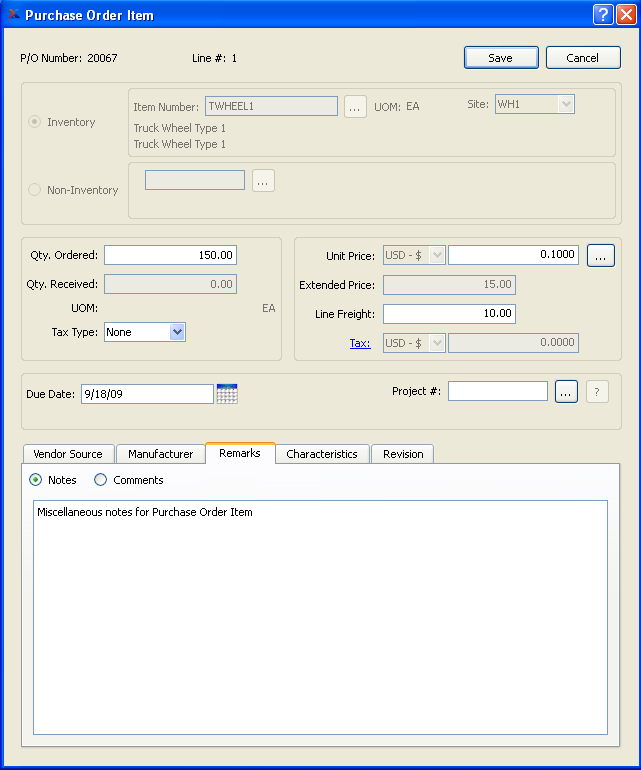
When entering miscellaneous Remarks to a Purchase Order Item, you are presented with the following options:
- Notes
This is a scrolling text field with word-wrapping for entering Notes related to the Purchase Order Line Item.
- Comments
To view system-generated Comments associated with an Item—or to add new Comments of your own—select the "Comments" option.
To the far right of the screen, the following buttons are available:
- NEW
Opens screen for creating a new Comment. Purchase Order Line Item Comments may only be added after the Line Item has been saved to the Purchase Order.
- VIEW
Highlight a Comment and then select this button to reach a read-only view of the Comment.
If an Item has Characteristics associated with it, you have the option of linking those Characteristics to a Purchase Order Item. In the case where Sales Order demand generates a Purchase Request, Item Characteristics and Values inherited from the Sales Order will already be linked to the Purchase Order. Ultimately, Characteristics associated with a Purchase Order Item may be printed on the Purchase Order report.
Tip
You can link Characteristics and Values to an Item by using the Item master. Once entered, these Characteristics and Values will be available to users entering Purchase Order Items.
To specify or edit Characteristics for a Purchase Order Item, select the "Characteristics" tab at the bottom of the screen. The following screen will appear:
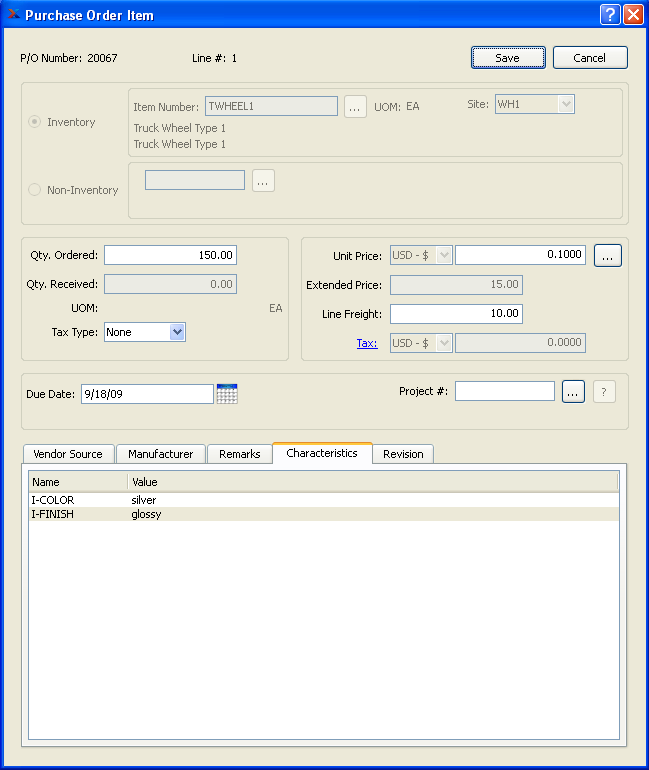
When selecting or editing Characteristics for a Purchase Order Line Item, you are presented with the following options:
- Name
Displays the name of any Item Characteristics associated with the Item. Characteristics defined as Item Characteristics may be associated with Items on the Item master.
- Value
Displays the default Value associated with an Item Characteristic, but permits you to specify an alternate Value. When associating Characteristic Values with a Purchase Order Item, you have four options: 1) Select the default Value; 2) select an alternate pre-defined Value; 3) manually enter a new Value in place of the pre-defined Value; or 4) make no selection. Making no selection means the Characteristics will not be associated with the Purchase Order Item—except in the case of Characteristics inherited from Sales Orders, by way of Purchase Requests.
When ordering purchased Items, you have the option to specify which Revision of the Item's Bill of Materials and Bill of Operations you want to buy. By default, the active Revision will be used. To specify Revision information for a Purchase Order Item, select the "Revision" tab. The following screen will appear:
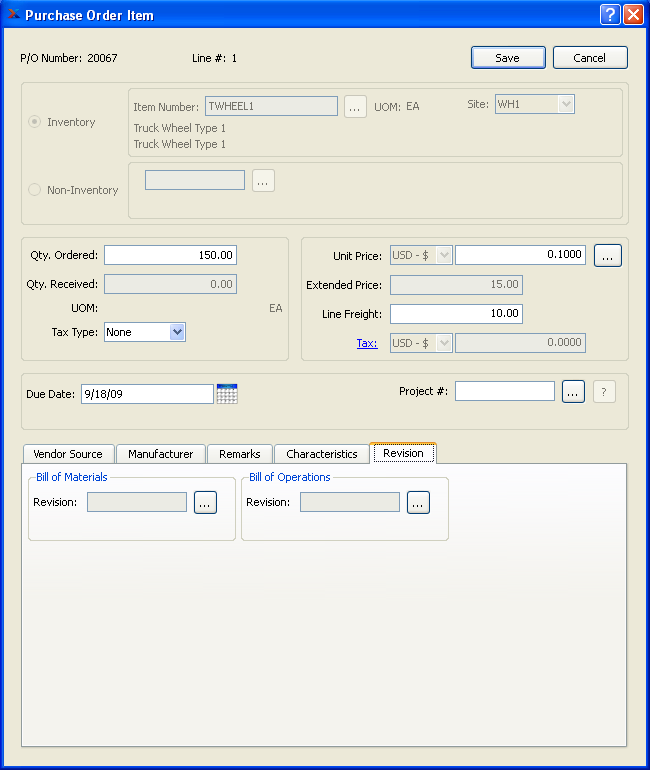
Note
You may create Purchase Order Items for pending Revisions. For Purchase Order purposes, a pending Revision is considered to be the same as an inactive Revision. The Revision status of a pending Revision will not be changed if a Purchase Order Item is created for it.
When specifying Revision information for a Purchase Order Item, you are presented with the following options:
- Bill of Materials
Specify the BOM Revision you want to use for the Purchase Order Item. By default, the active Revision will be used.
- Revision
Select from the list of existing available Revisions. The status of the Revision will also be displayed.
- Bill of Operations
Specify the BOO Revision you want to use for the Purchase Order Item. By default, the active Revision will be used.
- Revision
Select from the list of existing available Revisions. The status of the Revision will also be displayed.
The List Unposted Purchase Orders screen displays both unposted and unvouchered Purchase Orders. From this screen you may create new or edit existing Purchase Orders. To see the list of unposted and/or unvouchered Purchase Orders, select the "List Unposted Purchase Orders" option. The following screen will appear:

Note
Unposted Purchase Orders are considered to be a valid source of supply by the planning systems.
The "Unposted Purchase Orders" screen displays information on all existing unposted Purchase Orders, including Purchase Order Number, Vendor name, Order due date, status, and printed status. The "Search For" field will locate records by Purchase Order Number or Vendor description. Use the NEXT button to move to the next match in your search. You nay also include in the list open Purchase Orders which have not yet been vouchered by selecting the "Show All Unvouchered P/Os" option.
Tip
You may select multiple Purchase Orders for printing or posting by highlighting them using your mouse—or a combination of your mouse and either the SHIFT or CTRL keys.
To the far right of the screen, the following buttons are available:
- CLOSE
Closes the screen, returning you to the application desktop.
- NEW
Opens screen for creating a new Purchase Order.
- EDIT
Enables you to edit highlighted Purchase Order. The edit screen is the same as that for creating a new Purchase Order—except that when editing, the fields will contain Purchase Order information. Double-clicking on a Purchase Order will also bring you to the editing screen.
Tip
You can edit posted Purchase Orders if you select the "Show All Unvouchered POs" option, which displays all posted POs which have not yet been vouchered.
- VIEW
Highlight a Purchase Order and then select this button to reach a read-only view of the "Edit" screen.
- DELETE
Highlight a Purchase Order and then select this button to remove the Purchase Order from the list.
- PRINT P/O
Highlight a Purchase Order and then select this button to print a copy of the selected Purchase Order. If the Vendor specified on the Purchase Order has an EDI Profile attached, you may encounter an EDI processing interface when printing the Purchase Order.
- POST P/O
Highlight a Purchase Order and then select this button to post the selected Purchase Order.
To post a Purchase Order, select the "Post Purchase Order" option. The following screen will appear:

When posting a Purchase Order, you are presented with the following options:
- P/O #
Enter the Purchase Order Number of the Purchase Order you want to post.
Note
Once a Purchase Order has been posted, Line Items can no longer be added to it.
To the far right of the screen, the following buttons are available:
- CANCEL
Closes the screen, returning you to the application desktop.
- POST
Posts the specified Purchase Order.
Voucher section.
To enter a new Voucher, select the "Enter New Voucher" option. The following screen will appear:

When entering a new Voucher, you are presented with the following options:
- Voucher #
Next available Voucher Number will automatically display, unless your system requires you to enter Voucher Numbers manually. Default values and input parameters for Voucher Numbers are configurable at the system level.
- PO Number
Enter the Purchase Order Number of the Purchase Order you want to create a Voucher for.
- Vendor
The name and address of the Vendor associated with the specified Purchase Order will display here.
- Amount to Distribute
Specify the dollar amount you intend to distribute to the Vendor for the specified Purchase Order. You may enter an amount greater than the amount due on the Purchase Order.
- Amount Distributed
Displays sum of all Line Item distributions for specified Purchase Order.
- Balance
Displays the difference between amount to distribute and amount distributed.
- Invoice Date
Enter an Invoice date for the Voucher. The Invoice date is used for determining the due date, based on the specified Terms.
- Distribution Date
Enter the date of the current distribution. When the Voucher is posted, this is the date when the posting will be recorded in the General Ledger.
- Due Date
Enter the date payment is due to the Vendor. The due date is derived when the specified Terms are added to the Invoice date.
- Terms
Specify the billing Terms for the Voucher. By default, the billing Terms will be transferred from the original Purchase Order. You may select alternate Terms on the Voucher header.
Tip
You are given the opportunity to apply any billing Terms Discounts when selecting a posted Voucher for payment.
- Vendor Invoice #
Enter the Vendor Invoice Number associated with the specified Purchase Order. The system will issue a warning if you attempt to enter an Invoice Number which has already been used.
- Reference
Use this field to enter any notation or reference required for further identification.
- Tax Zone
Specify the Tax Zone which has jurisdiction over the transaction. By default, the Tax Zone specified on the selected Purchase Order will be used.
- Flag for 1099
Select to flag transaction for Form 1099 Tax reporting. This is informational only and does not impact Tax calculations.
- Line Items
Display lists Line Items associated with the specified Purchase Order.
To the far right of the screen, the following buttons are available:
- CANCEL
Closes the screen without entering a new Voucher, returning you to the application desktop.
- SAVE
Creates the new Voucher.
- DISTRIBUTIONS
Highlight a Purchase Order Line Item and then select this button to reach the Voucher Item distribution screen.
- DISTRIBUTE LINE
Highlight a Purchase Order Line Item(s) and then select this button to automatically distribute all quantities and amounts for the selected Voucher Item(s).
- CLEAR
Highlight a Purchase Order Line Item(s) and then select this button to automatically clear any distributions.
- DISTRIBUTE ALL
Select to distribute quantities and amounts for all Voucher Items.
Tip
You may select multiple Purchase Order Line Items for distribution or clearing by highlighting them using your mouse—or a combination of your mouse and either the SHIFT or CTRL keys.
To add miscellaneous Cost distributions to a Voucher, select the "Misc. Distributions" tab. The following screen will appear:
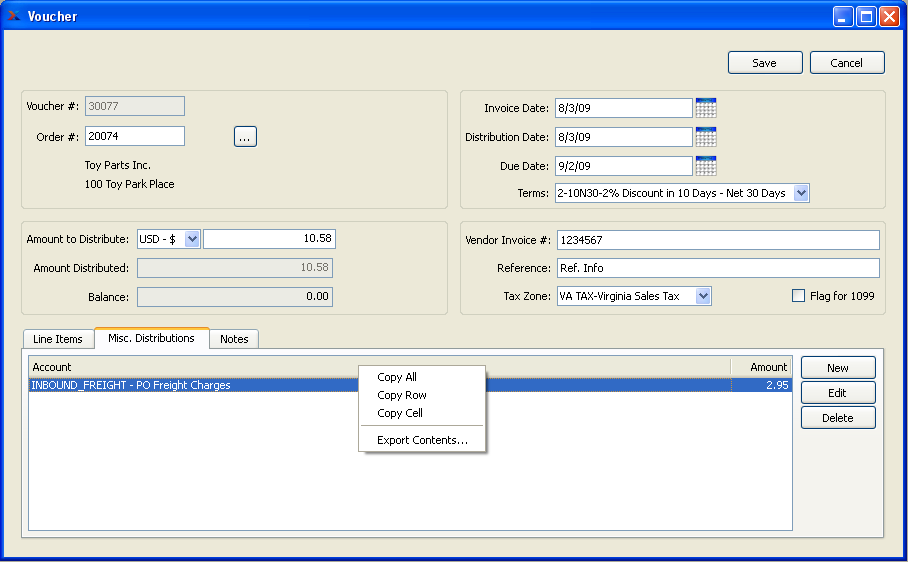
When adding miscellaneous distributions to a Voucher, you are presented with the following options:
- Account
Display lists Accounts and distribution amounts for any miscellaneous distributions associated with the Voucher.
To the far right of the screen, the following buttons are available:
- NEW
Select to enter a new miscellaneous distribution.
- EDIT
Enables you to edit highlighted miscellaneous distributions. The edit screen is the same as that for creating a new miscellaneous distribution—except that when editing, the fields will contain miscellaneous distribution information. Double-clicking on a miscellaneous distribution will also bring you to the editing screen.
- DELETE
Highlight a miscellaneous distribution and then select this button to remove the miscellaneous distribution from the list.
To add Notes to a Voucher, select the "Notes" tab. The following screen will appear:
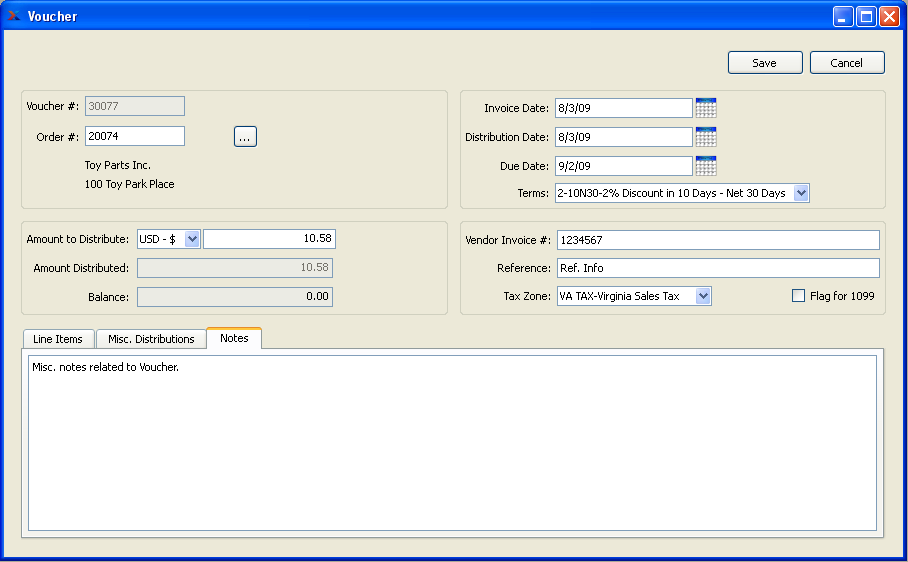
When adding Notes to a Voucher, you are presented with the following options:
- Notes
This is a scrolling text field with word-wrapping for entering general Notes related to the Sales Order. These Notes are for internal use only.
To distribute quantities from Purchase Order Line Items to the Voucher, highlight a Line Item and then select the DISTRIBUTIONS button. The following screen will appear:
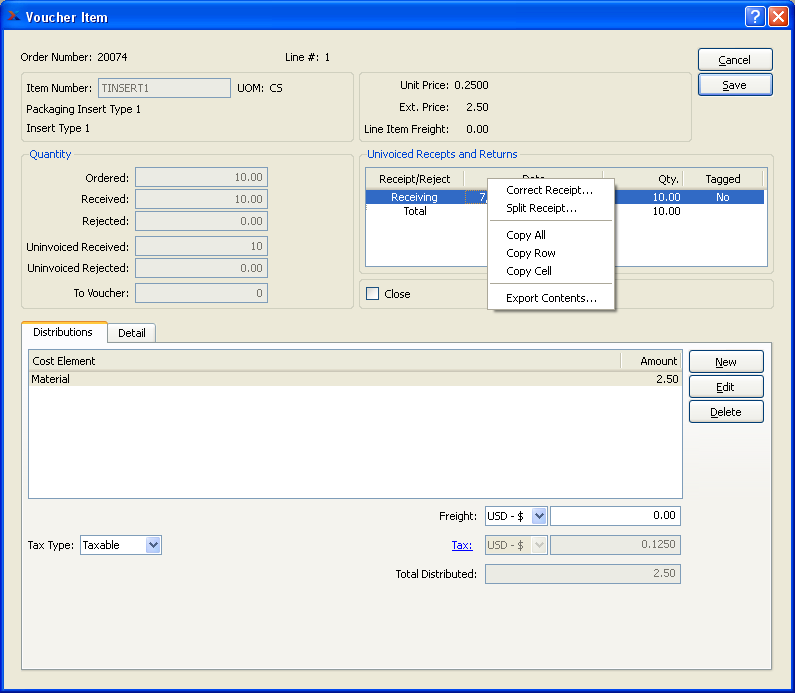
Note
An Item's per unit Actual Cost will be automatically updated after a Voucher is posted if the vouchered Cost differs from the Item's current Actual Cost. The vouchered Cost for an Item is determined by dividing the amount to distribute by the quantity to voucher.
When distributing quantities from a Purchase Order Line Item to the Voucher, you are presented with the following options:
- Order Number
Displays Purchase Order Number specified on previous screen.
- Line #
Displays Line Item selected for distribution on previous screen.
- Item Number
Displays Item Number associated with specified Line Item.
- UOM
Inventory Unit of Measure.
- Line Item Price Information
Displays the following price information for the P/O Line Item:
- Unit Price
Displays the Unit Price for the Line Item.
- Ext. Price
Displays the Extended Price for the Line Item.
- Line Item Freight
Displays the amount of Line Item Freight, if any.
- Quantity
Displays the following quantity information for the P/O Line Item:
- Ordered
Displays the quantity ordered for the Line Item.
- Received
Displays the quantity received to date of the Line Item.
- Rejected
Displays the quantity rejected to date of the Line Item.
- Uninvoiced Received
Displays the uninvoiced quantity received to date of the Line Item.
- Uninvoiced Rejected
Displays the uninvoiced quantity rejected to date of the specified Line Item.
- To Voucher
This is a read-only field displaying the Purchase Order Line Item quantity tagged to be vouchered for the given Voucher Item. The quantity displayed equals the tagged received qty. minus any returned qty. which may also have been tagged. The quantity to voucher is a divisor applied to the distribution amount. The resulting amount—that is, the Voucher Item distribution amount divided by the quantity vouchered—determines the per unit Actual Cost for an Item. The system will automatically handle any differences between the Inventory and Vendor UOMs—if any differences exist.
Tip
If you want to partially pay for a Receipt—but find you cannot edit the value in the "Qty. to Voucher" field—you should first correct the quantity on the original Receipt to be the amount you want to pay for, then enter a second Receipt for the balance. To correct Receipt quantities, use the right-click menu on the "Uninvoiced Receipts and Returns" screen.
- Uninvoiced Receipts and Returns
Display lists uninvoiced Receipts and Returns for the specified Line Item. To change the tagged status for a Line Item, double-click on the quantity in the Uninvoiced Receipts and Returns display. If a received (or returned) quantity has been tagged "Yes," this means the quantity will be marked as invoiced when the Voucher is posted.
Tip
You can split or correct a Receipt by right-clicking on a line item in the Uninvoiced Receipts and Returns window.
- Close
Select to close the Line Item automatically when the Voucher is posted. This flag will be selected automatically if the received quantity tagged for vouchering is equal to or greater than the Order quantity.
- Distributions
Display lists Costing Elements used for distributing Voucher Costs. At the bottom of the display the total amount distributed will display. This total includes Costing Element distributions and any Purchase Order Line Item freight charges.
- Tax Type
Specify the Tax Type for the Line Item. By default, the Tax Type specified on the selected Purchase Order will be used
- Freight
Enter the amount of any Purchase Order Line Item freight charges. The freight amount entered in this field will be added to the total amount for the Voucher Item. If you are vouchering for less than the original quantity ordered—and if Line Item freight was entered when the Purchase Order was created—then you should consider adjusting the Line Item freight amount accordingly. To make this adjustment, multiply the quantity you are vouchering by the per unit freight charge. The per unit freight charge is determined by dividing the original Line Item freight amount by the original Line Item quantity.
- Tax
Displays the amount of Tax associated with the Line Item, if any.
- Total Distributed
Displays the total amount distributed for the Line Item.
To the far right of the screen, the following buttons are available:
- CANCEL
Closes the screen, returning you to the previous screen.
- SAVE
Saves the Line Item information and adds it to the Voucher.
- NEW
Opens screen for adding a new Costing Element to the distribution list.
- EDIT
Enables you to edit highlighted Costing Element. The edit screen is the same as that for adding a new Costing Element—except that when editing, the fields will contain Costing Element information. Double-clicking on a Costing Element will also bring you to the editing screen.
- DELETE
Highlight a Costing Element and then select this button to remove the Costing Element from the list.
To view detailed Line Item information, select the "Detail" tab. The following screen will appear:
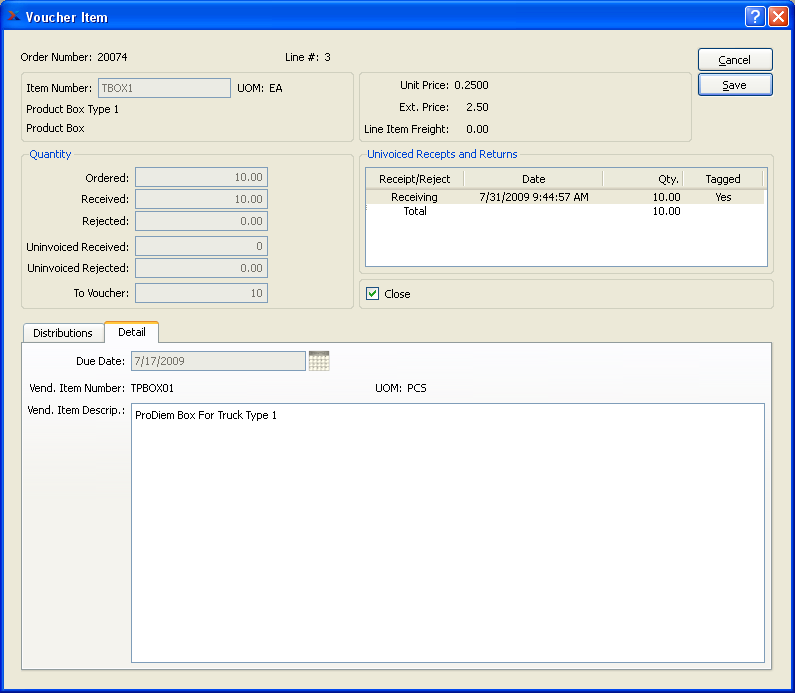
When viewing detailed Line Item information, you are presented with the following options:
- Due Date
Displays the date the Line Item was expected to be received, based on the Purchase Order information.
- Vend. Item Number
Displays the Item number the Vendor assigns to the specified Item from the Item Source record.
- UOM
Displays the Unit of Measure used by the Vendor for the specified Item from the Item Source record.
- Vend. Item Descrip.
Displays the description the Vendor uses to describe the specified Item from the Item Source record.
To distribute purchasing Costs to specific Costing Elements for the Item quantity being vouchered, select the NEW button. The following screen will appear:
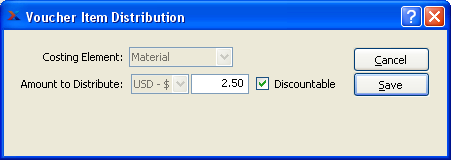
Note
An Item's per unit Actual Cost will be automatically updated after a Voucher is posted if the vouchered Cost differs from the Item's current Actual Cost. The vouchered Cost for an Item is determined by dividing the amount to distribute by the quantity to voucher.
When distributing purchasing Costs to a specific Costing Element, you are presented with the following options:
- Costing Element
Specify the Costing Element you want to distribute purchasing Costs to. The "Material" Costing Element will be selected by default once Line Item quantity has been tagged. You may distribute Costs to more than one Costing Element per Voucher Item. The list of available Costing Elements includes the system-defined "Material" Costing Element, as well as any user-defined Costing Elements designated as available to accept Purchase Order distributions.
Tip
Be sure to specify the amount to distribute based on the pricing found on the Purchase Order. The system will automatically handle any calculations required to accommodate Inventory/Vendor Unit of Measure (UOM) ratios which are not 1:1.
- Amount to Distribute
Specify the purchasing amount to distribute to the specified Costing Element. By default, the extended Price for the Purchase Order Line Item will be entered here once Line Item quantity has been tagged. Any difference between the distribution amount and the current Actual Cost amount for the Costing Element will result in the posting of automatic updates to the current Actual Cost when the Voucher is posted.
- Discountable
Select if the Voucher Item is entitled to a Terms discount. This option may be used on a line-by-line basis—all within one Voucher. For example, purchased Items may be discountable; however, freight charges may not be. When selecting a Voucher for payment within the discount period, only discountable Items will be discounted.
To the far right of the screen, the following buttons are available:
- CANCEL
Closes the screen, returning you to the previous screen.
- SAVE
Saves the distribution information and adds it to the distribution list.
To split a Purchase Order Receipt into different, smaller quantities, highlight a Receipt and then select the "Split Receipt" option from the right-click menu. The following screen will appear:
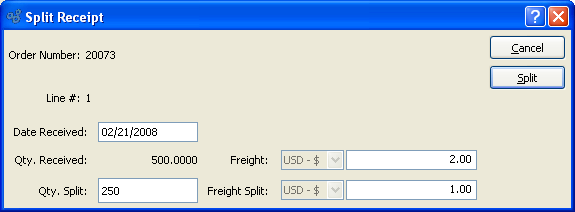
When splitting a Receipt quantity, you are presented with the following options:
- Order Number
Displays the Order Number of the Purchase Order whose Receipt is to be split.
- Line #
Displays the specific Purchase Order Line Item to be split.
- Date Received
By default, the date of the original Receipt will be displayed here. However, you may change the date.
- Qty. Received
Displays the quantity received for the selected Line Item.
- Qty. Split
Enter the quantity you want to split off from the original Receipt quantity. A new Receipt line will be created in the quantity specified here.
- Freight
By default, the original Freight amount will be displayed here. However, you may change the Freight amount.
- Freight Split
Enter the amount you want to split off from the original Freight amount. The new Freight amount will be added to the new Receipt line.
To the far right of the screen, the following buttons are available:
- CANCEL
Closes the screen, returning you to the previous screen.
- SPLIT
Select to create a new Receipt line using the specified parameters.
In addition to Line Item specific distributions, you may also enter miscellaneous distributions to affect the Voucher as a whole. To enter a miscellaneous distribution, select the NEW button from the main Voucher screen. The following screen will appear:
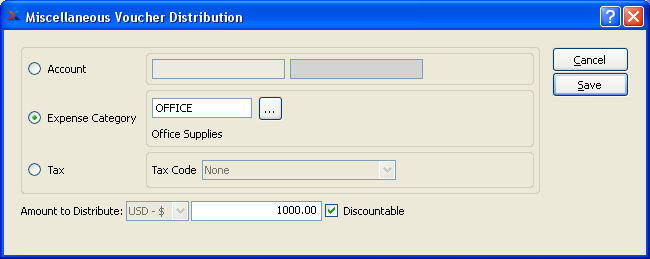
When entering a miscellaneous Voucher distribution, you are presented with the following options:
- Distribution Options
Select one of the following distribution options:
- Account
Select a General Ledger Account to use for the distribution.
- Expense Category
Select an Expense Category to use for the distribution.
- Tax
Select a Tax Code to use for the distribution.
- Amount to Distribute
Specify the amount of the miscellaneous distribution. If there is a balance still to be distributed once all Voucher Items have been distributed, then that remaining amount will be entered here by default.
- Discountable
Select if the Voucher Item is entitled to a Terms discount. This option may be used on a line-by-line basis—all within one Voucher. For example, purchased Items may be discountable; however, freight charges may not be. When selecting a Voucher for payment within the discount period, only discountable Items will be discounted.
To the far right of the screen, the following buttons are available:
- CANCEL
Closes the screen, returning you to the previous screen.
- SAVE
Saves the information and adds it to the list of miscellaneous distributions, simultaneously adjusting both the Voucher amount distributed and the balance distributed.
Miscellaneous Vouchers can be used to authorize payments for non-Inventory goods or services. You might use a miscellaneous Voucher, for example, to authorize payment for Utility bills or other non-Inventory expenses. To enter a Miscellaneous Voucher, select the "Enter New Miscellaneous Voucher" option. The following screen will appear:
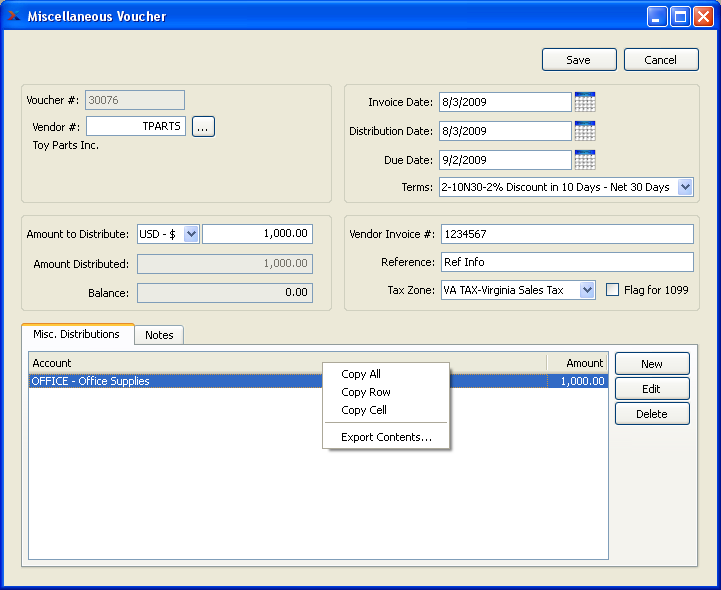
Note
A Voucher posts to the General Ledger effective on the Invoice Date entered on the Voucher—not on the date it is posted, as might be assumed.
When entering a new Voucher, you are presented with the following options:
- Voucher #
Next available Voucher Number will automatically display, unless your system requires you to enter Voucher Numbers manually. Default values and input parameters for Voucher Numbers are configurable at the system level.
- Vendor #
Enter the Vendor number of the Vendor you want to enter a Miscellaneous Voucher for.
- Amount to Distribute
Specify the dollar amount you intend to distribute to the Vendor for the Miscellaneous Voucher.
- Amount Distributed
Displays sum of all miscellaneous distributions for the Miscellaneous Voucher.
- Balance
Displays the difference between amount to distribute and amount distributed.
- Invoice Date
Enter an Invoice date for the Voucher. The Invoice date is used for determining the due date, based on the specified Terms.
- Distribution Date
Enter the date of the current distribution. When the Voucher is posted, this is the date when the posting will be recorded in the General Ledger.
- Due Date
Enter the date payment is due to the Vendor. The due date is derived when the specified Terms are added to the Invoice date.
- Terms
Specify the billing Terms for the Voucher.
- Vendor Invoice #
Enter the Vendor Invoice Number associated with the Miscellaneous Voucher.
- Reference
Use this field to enter any notation or reference required for further identification.
- Tax Zone
Specify the Tax Zone which has jurisdiction over the transaction. By default, the Tax Zone for the specified Vendor will be used.
- Flag for 1099
Select to flag transaction for Form 1099 Tax reporting. This is informational only and does not impact Tax calculations.
- Miscellaneous Distributions
Display lists miscellaneous Cost distributions related to the Miscellaneous Voucher.
To the far right of the screen, the following buttons are available:
- CANCEL
Closes the screen without entering a new Miscellaneous Voucher, returning you to the application desktop.
- SAVE
Creates the Miscellaneous Voucher.
- NEW
Select to distribute Costs for the Miscellaneous Voucher.
- EDIT
Enables you to edit highlighted miscellaneous distributions. The edit screen is the same as that for creating a new miscellaneous distribution—except that when editing, the fields will contain miscellaneous distribution information. Double-clicking on a miscellaneous distribution will also bring you to the editing screen.
- DELETE
Highlight a miscellaneous distribution and then select this button to remove the miscellaneous distribution from the list.
To add Notes to a Miscellaneous Voucher, select the "Notes" tab. The following screen will appear:

When adding Notes to a Miscellaneous Voucher, you are presented with the following options:
- Notes
This is a scrolling text field with word-wrapping for entering general Notes related to the Sales Order. These Notes are for internal use only.
In addition to Line Item specific distributions, you may also enter miscellaneous distributions to affect the Voucher as a whole. To enter a miscellaneous distribution, select the NEW button from the main Voucher screen. The following screen will appear:

When entering a miscellaneous Voucher distribution, you are presented with the following options:
- Distribution Options
Select one of the following distribution options:
- Account
Select a General Ledger Account to use for the distribution.
- Expense Category
Select an Expense Category to use for the distribution.
- Tax
Select a Tax Code to use for the distribution.
- Amount to Distribute
Specify the amount of the miscellaneous distribution. If there is a balance still to be distributed once all Voucher Items have been distributed, then that remaining amount will be entered here by default.
- Discountable
Select if the Voucher Item is entitled to a Terms discount. This option may be used on a line-by-line basis—all within one Voucher. For example, purchased Items may be discountable; however, freight charges may not be. When selecting a Voucher for payment within the discount period, only discountable Items will be discounted.
To the far right of the screen, the following buttons are available:
- CANCEL
Closes the screen, returning you to the previous screen.
- SAVE
Saves the information and adds it to the list of miscellaneous distributions, simultaneously adjusting both the Voucher amount distributed and the balance distributed.
Vouchers may be posted individually or in groups using the Unposted Vouchers screen. After they are posted, open Vouchers may later be voided using the right-click menu on the Vendor history screen. To display unposted Vouchers, select the "List Unposted Vouchers" option. The following screen will appear:
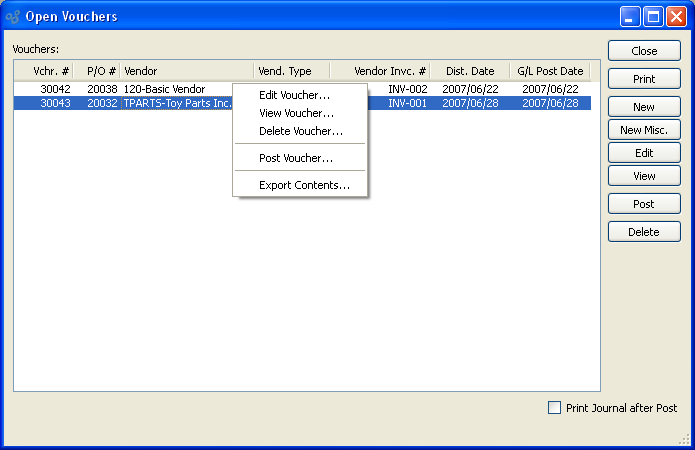
Note
Actual Costs for purchased Items will be automatically updated when Vouchers are posted if there are differences between current Actual Costs and the vouchered Costs for the Items in question. Please keep in mind that Actual Costs only will be updated at posting. For new Costs to be recognized as Standard Costs, Actual Costs must be posted to Standard.
The "Vouchers" screen displays information on all unposted Vouchers, including Voucher Number, Purchase Order Number, Vendor Number/Vendor name, Vendor Invoice Number, and distribution date. Users with the appropriate privilege will also see the G/L distribution date column.
Tip
You may select multiple Vouchers for posting by highlighting them using your mouse—or a combination of your mouse and either the SHIFT or CTRL keys.
To the far right of the screen, the following buttons are available:
- CLOSE
Closes the screen, returning you to the application desktop.
Runs the report associated with this screen.
- NEW
Opens screen for creating a new Voucher.
- NEW MISC.
Opens screen for creating a new Miscellaneous Voucher.
- EDIT
Enables you to edit highlighted Vouchers. The edit screen is the same as that for creating a new Voucher—except that when editing, the fields will contain Voucher information. Double-clicking on a Voucher will also bring you to the editing screen.
- VIEW
Highlight a Voucher and then select this button to reach a read-only view of the "Edit" screen.
Tip
If you have a Purchase Order Voucher that was corrupted by, for example, a sudden power outage, you can clear the record by running the Post Vouchers screen. In most cases, this action will remove the corrupted record and allow you to voucher the Purchase Order with a fresh Voucher.
- POST
Highlight one—or multiple—Vouchers, then select this button to post the selected Voucher(s). By default, Vouchers post to the General Ledger (G/L) on their distribution date. However, users with the appropriate privilege may change the G/L distribution date to an alternate date during the Voucher posting process. If used, Vouchers will post on the alternate date. The ability privileged users have to change the distribution date applies to the posting of both individual and also batches of Vouchers from this screen.
- DELETE
Highlight a Voucher and then select this button to remove the Voucher from the list.
- Print Journal after Post
Select if you want to print a copy of the Payables Journal after the selected Vouchers are posted.
To post Vouchers in batch mode, select the "Post Vouchers" option. The following screen will appear:

Note
Actual Costs for purchased Items will be automatically updated when Vouchers are posted if there are differences between current Actual Costs and the vouchered Costs for the Items in question. Please keep in mind that Actual Costs only will be updated at posting. For new Costs to be recognized as Standard Costs, Actual Costs must be posted to Standard.
When posting Vouchers in batch mode, you are presented with the following options:
- Print Payables Journal
Select to print your Accounts Payable Journal when posting Vouchers.
Tip
If you have a Purchase Order Voucher that was corrupted by, for example, a sudden power outage, you can clear the record by running the Post Vouchers screen. In most cases, this action will remove the corrupted record and allow you to voucher the Purchase Order with a fresh Voucher.
To the far right of the screen, the following buttons are available:
- CANCEL
Closes the screen, returning you to the application desktop.
- POST
Posts the specified Voucher.
A/P Memos section.
To enter a miscellaneous Credit Memo, select the "Enter Misc. Credit Memo" option. The following screen will appear:
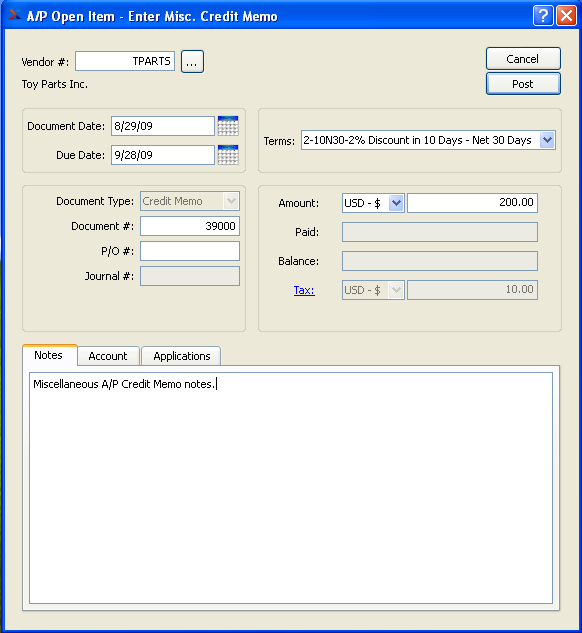
When entering a miscellaneous Credit Memo, you are presented with the following options:
- Vendor #
Enter the Vendor number of the Vendor you want to enter a miscellaneous Credit Memo for.
- Document Date
Specify a date to associate with the miscellaneous Credit Memo.
- Due Date
Displays the due date for the miscellaneous Credit Memo.
- Document Type
Displays the Document Type, namely "Credit Memo."
- Doc. Number
Displays the next available miscellaneous Credit Memo Number. The value for the next available Credit Memo Number can be configured at the system level.
- P/O #
Enter a Purchase Order Number to associate with the Credit Memo. You may leave this field blank if you do not want to enter an associated Purchase Order Number.
- Journal #
Displays the Journal number if any amount has been applied.
- Terms
By default, the Terms defined on the Vendor master for the specified Vendor will be used here.
- Amount
Specify the amount of the miscellaneous Credit Memo.
- Paid
Displays the amount applied to date for the miscellaneous Credit Memo.
- Balance
Displays the remaining amount still available to apply for the miscellaneous Credit Memo.
- Tax
Select the Tax hyperlink and enter applicable taxes.
- Notes
This is a scrolling text field with word-wrapping for entering Notes related to the miscellaneous Credit Memo.
To assign an alternate prepaid Account, select the "Account" tab at the bottom of the screen. The following screen will appear:

- Use Alternate Prepaid Account
Select one of the following optional prepaid Accounts:
Alternate Prepaid Account: Specify an alternate prepaid Account to use instead of the default prepaid Account.
Note
If an alternate prepaid Account is not specified, the system will use the default prepaid Account specified for the Vendor Type under A/P Account Assignments.
To view Applications, select the "Applications" tab at the bottom of the screen. The following screen will appear:

- Applications
Display lists the history of applications related to the miscellaneous Credit Memo, if any.
To the far right of the screen, the following buttons are available:
- CANCEL
Closes the screen without entering a miscellaneous Credit Memo, returning you to the application desktop.
- POST
Posts the miscellaneous Credit Memo, using the amount specified.
Whenever a Credit Memo amount has not been applied to a specific Voucher or Debit Memo—either in whole or in part—that Credit Memo will appear on the list of unapplied Credit Memos.
Note
A newly-entered miscellaneous Credit Memo is an unapplied Credit Memo by default.
To access the master list of unapplied Credit Memos, select the "List Unapplied Credit Memos" option. The following screen will appear:
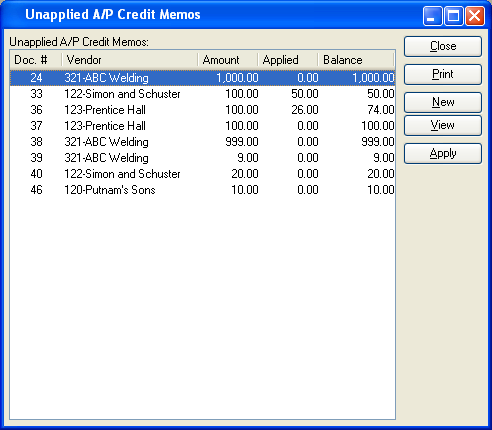
The master list of unapplied Credit Memos displays basic information on all existing unapplied Credit Memos, including Document Number, Vendor name, Document amount, applied amount, and amount available to apply.
Note
Once the full amount of a Credit Memo has been applied, the Credit Memo will be removed from the unapplied Credit Memos list.
To the far right of the screen, the following buttons are available:
- CLOSE
Closes the screen, returning you to the application desktop.
Runs the report associated with this screen.
- NEW
Opens screen for creating a new miscellaneous Credit Memo.
- VIEW
Highlight an unapplied Credit Memo and then select this button to reach a read-only view of the A/P open item.
- APPLY
Highlight an unapplied Credit Memo and then select this button to apply an amount.
To apply a Credit Memo amount, select the APPLY button. The following screen will appear:
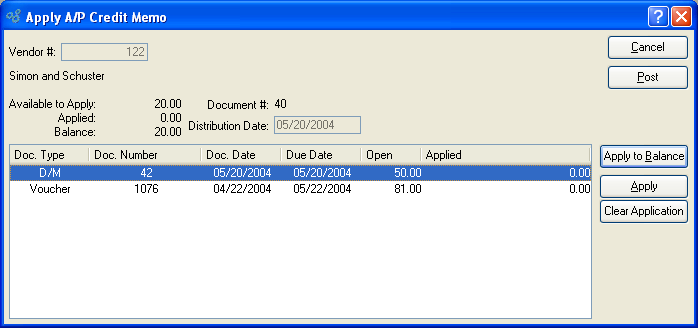
Note
Credit Memo amounts may be applied to either open Vouchers or open miscellaneous Debit Memos.
When applying a Credit Memo amount, you are presented with the following options:
- Vendor #
Displays the Vendor number of the Vendor associated with the unapplied Credit Memo amount. The Vendor name will also display.
- Available to Apply
Displays the Credit Memo amount which is available to be applied.
- Applied
Displays the amount of the Credit Memo applied to the specified Document.
- Balance
Displays the amount of the Credit Memo remaining to be applied, if any.
- Document #
Displays the Credit Memo Number.
- Distribution Date
Displays the date the Credit Memo applied amount was applied.
- Items
Display lists A/P open items for the specified Customer.
To the far right of the screen, the following buttons are available:
- CANCEL
Closes the screen without applying an amount to the Debit/Credit Memo, returning you to the application desktop.
- POST
Posts the applied amount to the General Ledger.
- APPLY TO BALANCE
Select to apply the available balance to the A/P open items. If the applied balance exceeds the amount due on an A/P open item, the remaining balance will be applied to the next open amount.
- APPLY
Highlight an Item and then select this button to apply an amount to the Item.
- CLEAR APPLICATION
Highlight an Item and then select this button to remove any amount applied toward the Item.
To apply a Credit Memo amount to an A/P open item, select the APPLY button. The following screen will appear:
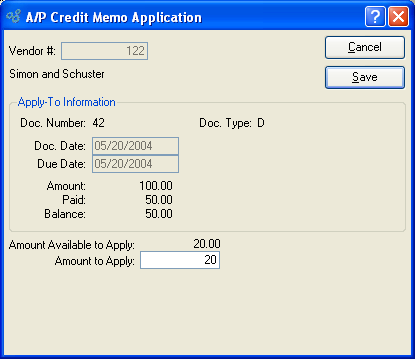
When applying a Credit Memo amount to an A/P open item, you are presented with the following options:
- Vendor #
Displays the Vendor number of the Vendor whose A/P open item the amount is being applied to. The Vendor name will also display.
- Doc. Number
Displays the Document Number associated with the A/P open item.
- Doc. Type
Displays the Document Type of the Document.
- Doc. Date
Displays the Document's origination date.
- Due Date
Displays the date the Document is due.
- Amount
Displays the original amount due for the selected Document.
- Paid
Displays the amount paid to date toward the original Document amount.
- Balance
Displays the remaining balance due.
- Amount Available to Apply
Displays the amount of the referring Credit Memo available to be applied.
- Amount to Apply
Specify the amount to apply to the A/P open item.
To the far right of the screen, the following buttons are available:
- CANCEL
Closes the screen without applying an amount to the Item, returning you to the application desktop.
- SAVE
Applies the amount to the Item.
A miscellaneous Debit Memo is like a Voucher—the main difference being that a miscellaneous Debit Memo is not necessarily linked to a Purchase Order. To enter a miscellaneous Debit Memo, select the "Enter Misc. Debit Memo" option. The following screen will appear:
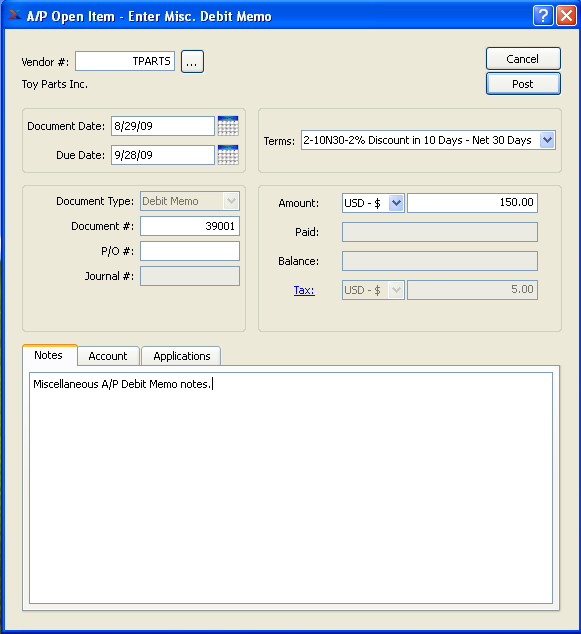
When entering a miscellaneous Debit Memo, you are presented with the following options:
- Vendor #
Enter the Vendor number of the Vendor you want to enter a miscellaneous Debit Memo for.
- Document Date
Specify a date to associate with the miscellaneous Debit Memo.
- Due Date
Displays the due date for the miscellaneous Debit Memo.
- Document Type
Displays the Document Type, namely "Debit Memo."
- Doc. Number
Displays the next available miscellaneous Debit Memo Number.
The value for the next available Debit Memo Number can be configured at the system level.
- P/O #
Enter a Purchase Order Number to associate with the Credit Memo. You may leave this field blank if you do not want to enter an associated Purchase Order Number.
- Journal #
Displays the Journal number if any amount has been applied.
- Terms
By default, the Terms defined on the Vendor master for the specified Vendor will be used here.
- Amount
Specify the amount of the miscellaneous Debit Memo.
- Paid
Displays the amount applied to date for the miscellaneous Debit Memo.
- Balance
Displays the remaining amount still available to apply for the miscellaneous Debit Memo.
- Tax
Select the Tax hyperlink and enter applicable taxes.
- Notes
This is a scrolling text field with word-wrapping for entering Notes related to the miscellaneous Debit Memo.
To assign an alternate prepaid Account, select the "Account" tab at the bottom of the screen. The following screen will appear:

- Use Alternate Prepaid Account
Select one of the following optional prepaid Accounts:
Alternate Prepaid Account: Specify an alternate prepaid Account to use instead of the default prepaid Account.
Note
If an alternate prepaid Account is not specified, the system will use the default prepaid Account specified for the Vendor Type under A/P Account Assignments.
To view Applications, select the "Applications" tab at the bottom of the screen. The following screen will appear:
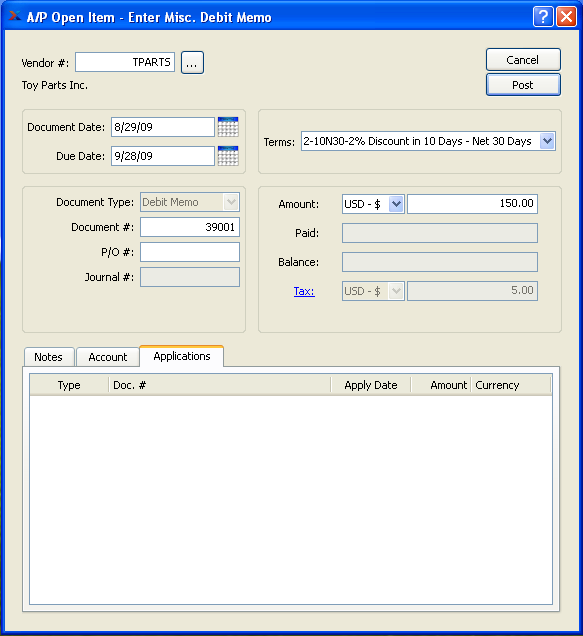
- Applications
Display lists the history of applications related to the miscellaneous Debit Memo, if any.
To the far right of the screen, the following buttons are available:
- CANCEL
Closes the screen without entering a miscellaneous Debit Memo, returning you to the application desktop.
- POST
Posts the miscellaneous Debit Memo, using the amount specified.
Before you can pay a Vendor an amount due, you must first select the relevant A/P open item(s) for payment. A/P open items are generated by the posting of Vouchers and miscellaneous A/P Debit Memos. To select an A/P open item for payment, choose the "Select Payments" option. The following screen will appear:
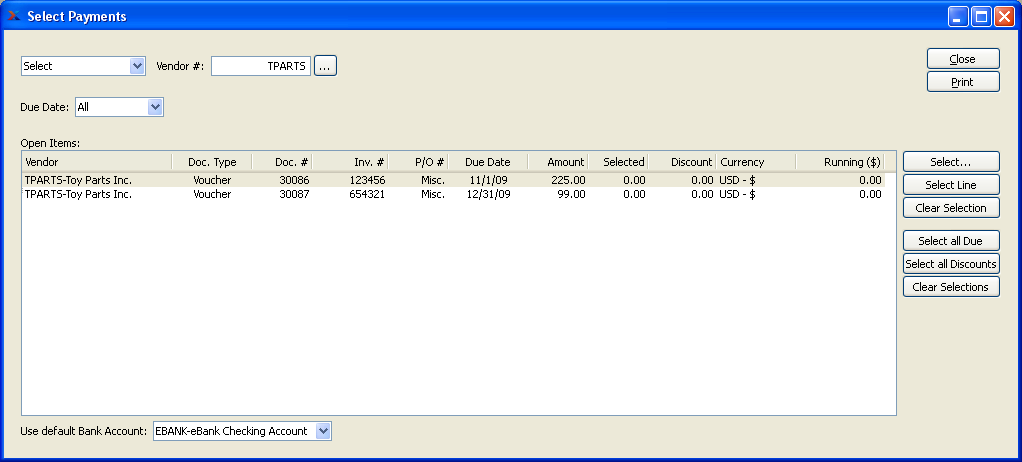
Tip
You may select multiple Vouchers for payment by using the SHIFT or CTRL keys and your mouse.
When selecting A/P open items for payment, you are presented with the following options:
- Show Open Items for
Select one of the following display options:
- All Vendors
Select to show A/P open items for all Vendors.
- Selected Vendor
Specify Vendor whose A/P open items you want to display.
- Selected Vendor Type
Specify Vendor Type whose A/P open items you want to display.
- Vendor Type Pattern
Enter a Vendor Type pattern to select a range of Vendor Types. Refine your search using Regular Expressions.
- Due Date
Select one of the following display options:
- All
Select to show all A/P open items for all due dates.
- Older than
Select to show A/P open items whose due date is older than the date entered.
- Due between
Select to show A/P open items whose due date falls within a specified range.
Note
When a Check is created to satisfy an A/P open item, the value displayed in the amount due column will be adjusted automatically to reflect the Check amount. For example, if a Check is issued for the full amount due, the value in the amount due column will adjust to "0". Once a Check for the full amount is posted, the A/P open item will be removed from the Select Payments list altogether.
- A/P Open Items
Display lists A/P open items. If a Document is past due, the line for that Document will display in red type.
Tip
Be alert to negative balances in the amount due column. A negative balance indicates that Checks have been issued for more than the amount due. To correct this situation, view your Check Run and void any superfluous Checks.
- Use default Bank Account
Specify the default Bank Account to be used whenever an A/P open item is selected for payment during the current session. If you select a Bank Account then only the A/P open items with the same Currency as the Bank Account's Currency are displayed. If you do not use this default option, you must specify a Bank Account each time you select an A/P open item for payment.
To the far right of the screen, the following buttons are available:
- CLOSE
Closes the screen, returning you to the application desktop.
Runs the report associated with this screen.
- SELECT
Highlight an A/P open item and then click this button to manually review and select the Item for payment. This option brings you to the individual Select Payment screen, where you will find the full range of payment options.
- SELECT LINE
Highlight an A/P open item and then click this button to automatically select the open item for payment. Any available Terms Discount will also be applied automatically.
- CLEAR SELECTION
Highlight an A/P open item and then select this button to clear the selected payment. This option effectively reverses the action of the SELECT option.
- SELECT ALL DUE
Select this button to select for payment all A/P open items whose Payment Date is due or past due and whose Currency is the same as the Bank Account's Currency.
- SELECT ALL DISCOUNTS
Select this option to automatically select all A/P open items which are eligible for a Terms Discount and whose Currency is the same as the Bank Account's Currency. The Terms Discount will be applied automatically to all selected open items.
- CLEAR SELECTIONS
Select this button to clear all selected payments due. This option effectively reverses the action of the SELECT ALL DUE option.
To select for payment all A/P open items whose payment date is due or past due, choose the SELECT ALL DUE button. The following screen will appear:

When selecting for payment all A/P open items whose payment date is due or past due, you are presented with the following options:
- Bank Account
Specify the Bank Account to be used for paying all selected payments due.
To the far right of the screen, the following buttons are available:
- CANCEL
Closes the screen without specifying a Bank Account, returning you to the application desktop.
- SELECT
Select this button to use the specified Bank Account for paying payments due.
To select a individual A/P open item for payment, choose the SELECT button. The following screen will appear:
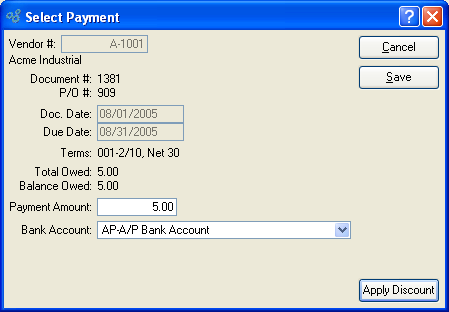
When specifying payment details for a selected A/P open item, you are presented with the following options:
- Vendor #
Displays the name of the Vendor who is owed payment.
- Document #
Displays the Document Number of the Document being selected for payment.
Valid Document Types include posted Vouchers and miscellaneous A/P Debit Memos.
- P/O #
Displays the Purchase Order Number (if any) of the Purchase Order associated with the Document.
- Doc. Date
Displays the Document's origination date.
In the case of a Voucher, the Document date is the same as the Invoice date.
- Due Date
Displays the date payment is due.
The due date is determined based on the billing Terms selected at the time the Document is posted.
- Terms
Displays the billing Terms selected at the time the Document was posted.
- Total Owed
Displays the total amount due to the Vendor.
The total owed is equal to the vouchered amount—or to the amount of the miscellaneous A/P Credit Memo at the time of posting.
- Balance Owed
Displays the balance due to the Vendor.
The balance owed will differ from the total owed if Discounts are applied based on the specified billing Terms.
- Payment Amount
Specify the amount to be paid to the Vendor. If a billing Terms Discount is applied, the payment amount will be reduced automatically by the Discount amount.
Note
The payment amount is the amount which appears on A/P Checks when they are created.
- Bank Account
Specify the Bank Account to be used for paying the A/P open item.
To the far right of the screen, the following buttons are available:
- CANCEL
Closes the screen without specifying payment details, returning you to the application desktop.
- SAVE
Creates and saves the payment details.
- APPLY DISCOUNT
Select to apply any billing Terms Discount you may be eligible for.
To apply a billing Terms Discount and have the Discount amount deducted from the total owed, select the APPLY DISCOUNT button. The following screen will appear:
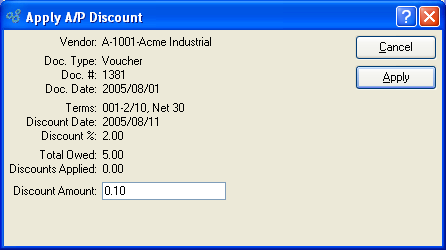
Note
Discounts are posted to the General Ledger (G/L) when the Check they are associated with is posted. Any time prior to the posting of the Check, the Discount can be edited or reversed.
When applying a billing Terms Discount, you are presented with the following options:
- Vendor #
Displays the name of the Vendor who is owed payment.
- Doc. Type
Displays the Document Type. Valid Document Types include posted Vouchers and miscellaneous A/P Debit Memos.
- Doc #
Displays the Document Number of the Document being selected for payment.
- Doc. Date
Displays the Document's origination date. In the case of a Voucher, the Document date is the same as the Invoice date.
- Terms
Displays the billing Terms selected at the time the Document was posted.
- Discount Date
Displays the expiration date for the billing Terms Discount period. The Discount date will display in red type once the Discount period has expired. Once the Discount period has expired, the system will no longer automatically update the Discount amount field.
- Discount %
Displays the Discount percentage, as specified in the billing Terms.
- Total Owed
Displays the total amount due to the Vendor. The total owed is equal to the vouchered amount—or to the amount of the miscellaneous A/P Credit Memo at the time of posting.
- Discounts Applied
Displays the amount of any Discounts previously applied to the selected Document.
- Discount Amount
Enter the amount of the Discount to be applied to the total owed. As long as the Discount period has not expired, the system will automatically calculate the Discount amount for you. The Discount amount will be equal to the total owed multiplied by the Discount percentage. The Account used for posting Discounts to the General Ledger (G/L) is defined on the A/P Account Assignments screen.
To access the master list of selected payments, select the "List Selected Payments" option. The following screen will appear:

The "Selected Payments" screen displays information on all existing selected payments, including Bank Account to be paid from, Vendor name, Document Type, Document Number, Invoice Number, Purchase Order Number, amount selected for payment, and running total.
To the far right of the screen, the following buttons are available:
- CLOSE
Closes the screen, returning you to the application desktop.
Runs the report associated with this screen.
- EDIT
Enables you to edit highlighted selected payment. The edit screen is the same as that for creating new payment details—except that when editing, the fields will contain payment information. Double-clicking on a selected payment will also bring you to the editing screen.
- CLEAR SELECTION
Highlight a selected payment and then select this button to clear the selection. Because an Item that has been cleared is no longer selected for payment, this option removes the Item from the master list of selected payments.
To prepare a Check Run, select the "Prepare Check Run" option. The following screen will appear:

When preparing a Check Run, you are presented with the following options:
- Bank Account
Specify the Bank Account to be used for the Check Run.
- Check Date
Specify the date to appear on the Checks in the Check Run. By default, the current day's date will display. You may change the date in this field, thereby changing the date that will appear on the Checks being prepared.
To the far right of the screen, the following buttons are available:
- CANCEL
Closes the screen without preparing a Check Run, returning you to the application desktop.
- PREPARE
Prepares the Check Run.
For payments related to non-Inventory goods or services, you have the ability to create miscellaneous A/P Checks. You can write Checks to Vendors, Customers, or Tax Authorities. To create a miscellaneous Check, select the "Create Miscellaneous Check" option. The following screen will appear:
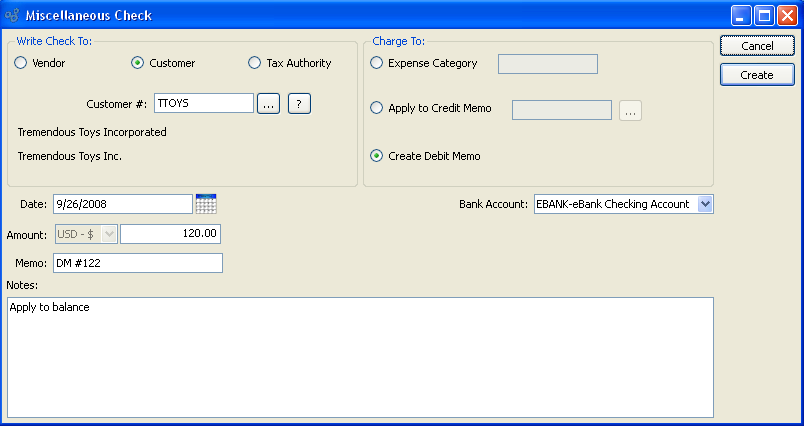
When creating a miscellaneous Check, you are presented with the following options:
- Write Check To
Specify which type of recipient you want to write the miscellaneous Check to. Your options will vary depending on which type you select.
- Vendor
Select if you want to write a Check to a Vendor. Once selected, you must also specify the Vendor.
- Customer
Select if you want to write a Check to a Customer. Once selected, you must also specify the Customer.
- Tax Authority
Select if you want to write a Check to a Tax Authority. Once selected, you must also specify the Tax Authority.
- Charge To:
Specify how you want to handle the accounting for the miscellaneous Check. Your options will vary depending on the recipient type you choose.
- Expense Category
Specify the Expense Category you want to distribute the payment to. This option is available for all recipient types.
- Apply to Credit Memo
This option is available only for Checks to Customers. If selected, you can choose a Credit Memo from the Customer's open balance. Then, when the miscellaneous Check is posted, the open Credit Memo will automatically be closed. Use this feature for paying off and closing open Customer balances.
- Create Credit Memo
This option is available only for Checks to Vendors. Once the miscellaneous Check is posted, a Credit Memo in the Check amount will be created. This Credit Memo will offset your Accounts Payable for the specified Vendor. You would use this option, for example, to handle prepayments made to Vendors.
- Create Debit Memo
This option is available only for Checks to Customers. You would use this in the case where you lent a Customer money, with the expectation of billing them later.
- Date
Specify the date to appear on the miscellaneous Check.
- Amount
Specify the amount of the miscellaneous Check.
- Memo
Enter a Memo line to be included on the bottom portion of the printed miscellaneous Check.
- Bank Account
Specify the Bank Account you want to use for the miscellaneous Check.
- Notes
This is a scrolling text field with word-wrapping for entering Notes related to the miscellaneous Check.
To the far right of the screen, the following buttons are available:
- CANCEL
Closes the screen without creating a miscellaneous Check, returning you to the application desktop.
- CREATE
Creates the miscellaneous Check, using the specified parameters.
To view a detailed list of Checks prepared to be run, select the "View Check Run" option. The following screen will appear:
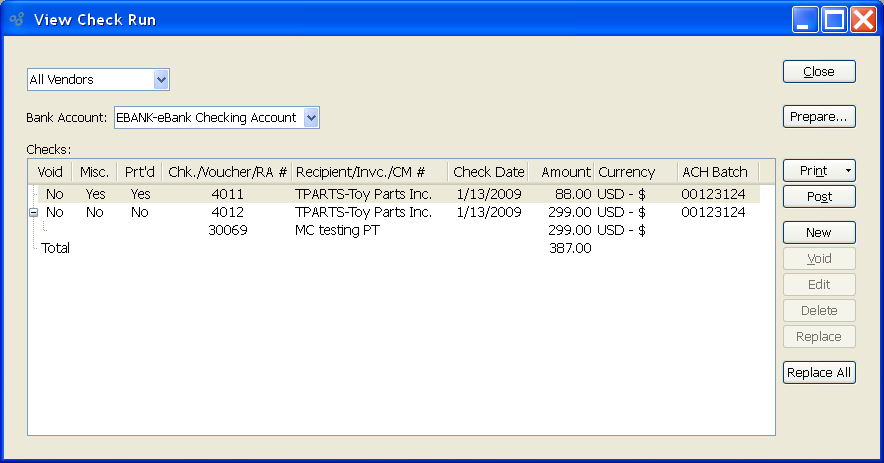
When viewing the detailed list of Checks prepared to be run, you are presented with the following options:
- Vendor
Select all or specific Vendors whose Checks you would like to view.
- Bank Account
Specify the Bank Account whose Check Run you want to view.
- Checks
Display lists details for Checks included in the Check Run. This display is a nested list, with a plus ("+") sign located to the far left of the display next to each Check. By clicking your mouse on a plus sign, you reveal lower levels of information related to the Check.
To the far right of the screen, the following buttons are available:
- CLOSE
Closes the screen, returning you to the application desktop.
- PREPARE
Select to prepare a Check Run. For more information on preparing Check Runs, see Section 1.4.3, “ Prepare Check Run”.
Select from one of the following print options. If the specified Bank Account is configured to use Automated Clearing House (ACH), you will be presented with the option to create an ACH file after selecting a print option.
- Selected Check
Highlight a Check in the list of Checks and then select this button to print the Check.
Tip
If Checks being printed contain reference lines which spill over and exceed one standard page, then consider using the report definition CheckMultiPage.xml. This Check Form is designed to support multiple pages for one Check number.
- Check Run
Select to print the Check Run, using the specified Bank Account. For more information on printing Check Runs, see Section 1.6.3, “ Print Check Run”.
- Edit List
Prints a copy of the pending Check Run for review.
- POST
Highlight a Check in the list of Checks and then select this button to post the Check. A Check must be printed before it can be posted. See the "Printed" column in the display to determine a Check's printed status.
- VOID
Highlight a Check in the list of Checks and then select this button to void the Check. Voided Checks may not be printed or posted. When a Check is voided, the payable amount will be reopened on the Select Payments screen. In other words, if a Check for $100.00 is voided, that amount will once again be made available for payment on the Select Payments screen. The reopened amount will again be associated with the referring payable Document (i.e., Voucher or Debit Memo).
- EDIT
Highlight a miscellaneous Check and then select this button to edit the Check. Only unprinted miscellaneous Checks may be edited.
Note
Only unprinted miscellaneous Checks may be edited. Regular Checks may not be edited.
- DELETE
Highlight a voided Check in the list of Checks and then select this button to delete the Check. Only voided Checks may be deleted.
- REPLACE
Highlight a voided Check in the list of Checks and then select this button to replace the Check. Checks must be voided before they can be replaced. When a voided Check is replaced, the payable amount displayed on the Select Payments screen will be removed. In other words, if a voided Check for $500.00 is replaced, that amount will no longer be available for payment on the Select Payments screen.
- REPLACE ALL
Select this button to replace all Checks shown in the list of Checks. Checks must be voided before they can be replaced.
You may occasionally have a need to void an entire Check Run—if, for example, you print the Check Run on the wrong kind of paper, etc. To void a Check Run, select the "Void Check Run" option. The following screen will appear:

When voiding a Check Run, you are presented with the following options:
- Bank Account
Specify the Bank Account whose associated Check Run you want to void.
- First Check #
Displays the first Check Number in the Check Run for the specified Bank Account.
- # of Checks to Void
Indicates the number of Checks in the Check Run to be voided. Check Numbers increment in intervals of one (1) beginning with the first Check Number displayed above.
- Issue Replacement Checks
Select to issue replacement Checks for the Checks being voided.
To the far right of the screen, the following buttons are available:
- CANCEL
Closes the screen without voiding the Check Run, returning you to the application desktop.
- VOID
Voids the Check Run, using the specified parameters.
To post an individual Check, select the "Post A/P Check" option. The following screen will appear:

When posting an individual Check, you are presented with the following options:
- Bank Account
Specify the Bank Account for the Check you want to post.
- Check #
Specify the number of the Check you want to post. Only printed Checks from prepared Check Runs associated with the specified Bank Account will appear in the list.
To the far right of the screen, the following buttons are available:
- CANCEL
Closes the screen without posting a Check, returning you to the application desktop.
- POST
Posts the Check, using the specified parameters.
To post multiple Checks, select the "Post A/P Checks" option. The following screen will appear:

When posting multiple Checks, you are presented with the following options:
To the far right of the screen, the following buttons are available:
- CANCEL
Closes the screen without posting a Check, returning you to the application desktop.
- POST
Posts the Check, using the specified parameters.
The Payables Workbench groups together in one location a range of current payables information. To access the Payables Workbench, select the "Workbench" option. The following screen will appear:
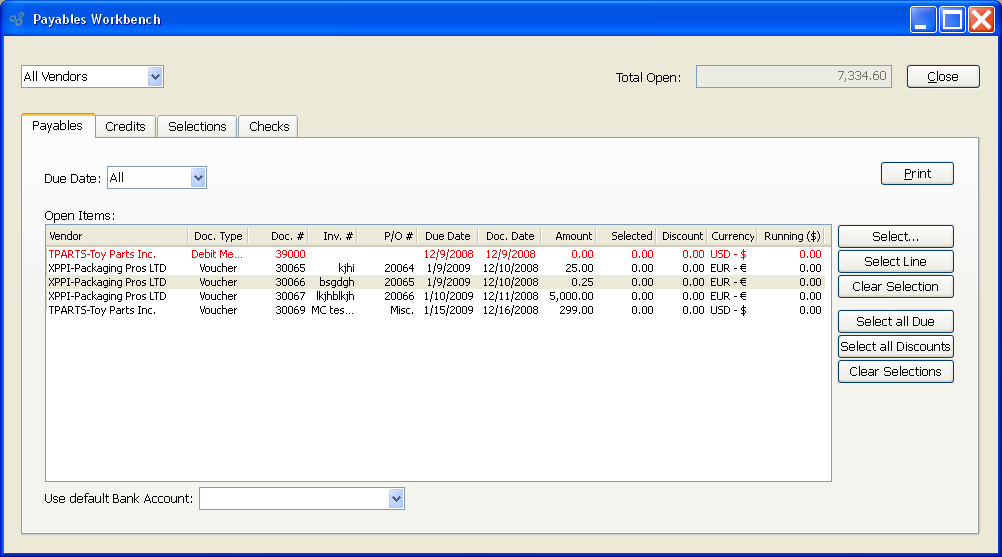
When displaying the list of Payables associated with the Vendor(s), you are presented with the following options:
- Vendor
Select all or specific Vendors whose payables you would like to view.
- Due Date
Specify date parameters to query open Payables.
- Open Items
Display lists A/P open items. If a Document is past due, the line for that Document will display in red type.
To the far right of the screen, the following buttons are available:
- CLOSE
Closes the screen, returning you to the application desktop.
Runs the report associated with this screen.
- SELECT
Highlight an A/P open item and then click this button to manually review and select the Item for payment. This option brings you to the individual Select Payment screen, where you will find the full range of payment options.
- SELECT LINE
Highlight an A/P open item and then click this button to automatically select the open item for payment. Any available Terms Discount will also be applied automatically.
- CLEAR SELECTION
Highlight an A/P open item and then select this button to clear the selected payment. This option effectively reverses the action of the SELECT option.
- SELECT ALL DUE
Select this button to select for payment all A/P open items whose Payment Date is due or past due and whose Currency is the same as the Bank Account's Currency.
- SELECT ALL DISCOUNTS
Select this option to automatically select all A/P open items which are eligible for a Terms Discount and whose Currency is the same as the Bank Account's Currency. The Terms Discount will be applied automatically to all selected open items.
- CLEAR SELECTIONS
Select this button to clear all selected payments due. This option effectively reverses the action of the SELECT ALL DUE option.
To view Credits associated with the Vendor(s), select the "Credits" tab. The following screen will appear:
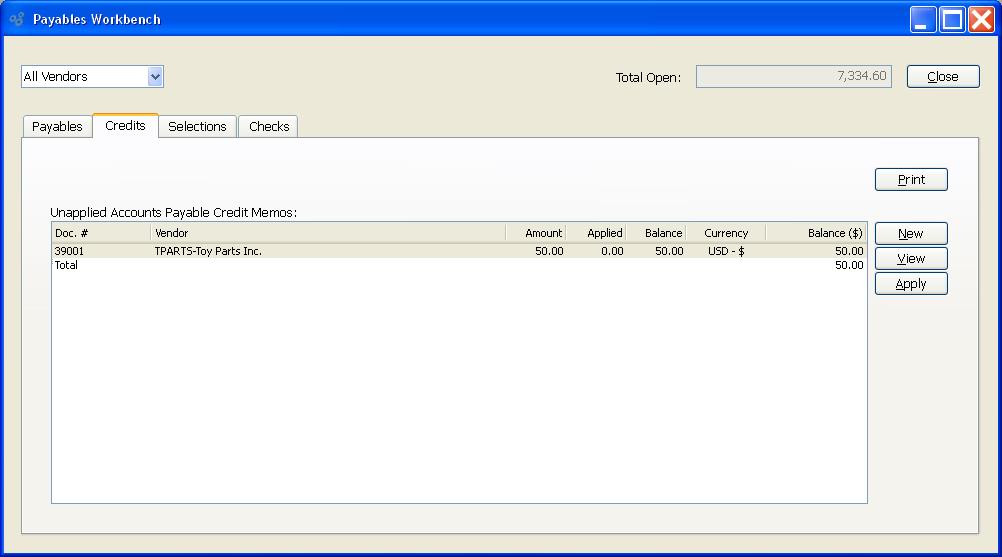
When displaying Credits associated with the Vendor(s), you are presented with the following options:
- Unapplied Accounts Payable Credit Memos
Displays the list of unapplied Credit Memos associated with the specified Vendor.
To the far right of the screen, the following buttons are available:
Runs the report associated with this screen.
- NEW
Opens screen for creating a new miscellaneous Credit Memo.
- VIEW
Highlight an unapplied Credit Memo and then select this button to reach a read-only view of the A/P open item.
- APPLY
Highlight an unapplied Credit Memo and then select this button to apply an amount.
To view the list of selected payments for the specified Vendor(s), select the "List Selected Payments" option. The following screen will appear:

The "Selected Payments" screen displays information on all existing selected payments, including Bank Account to be paid from, Vendor name, Document Type, Document Number, Invoice Number, Purchase Order Number, amount selected for payment, Currency, and running total.
To the far right of the screen, the following buttons are available:
Runs the report associated with this screen.
- EDIT
Enables you to edit highlighted selected payment. The edit screen is the same as that for creating new payment details—except that when editing, the fields will contain payment information. Double-clicking on a selected payment will also bring you to the editing screen.
- CLEAR SELECTION
Highlight a selected payment and then select this button to clear the selection. Because an Item that has been cleared is no longer selected for payment, this option removes the Item from the master list of selected payments.
To view the Check Run, select the "Checks" tab. The following screen will appear:
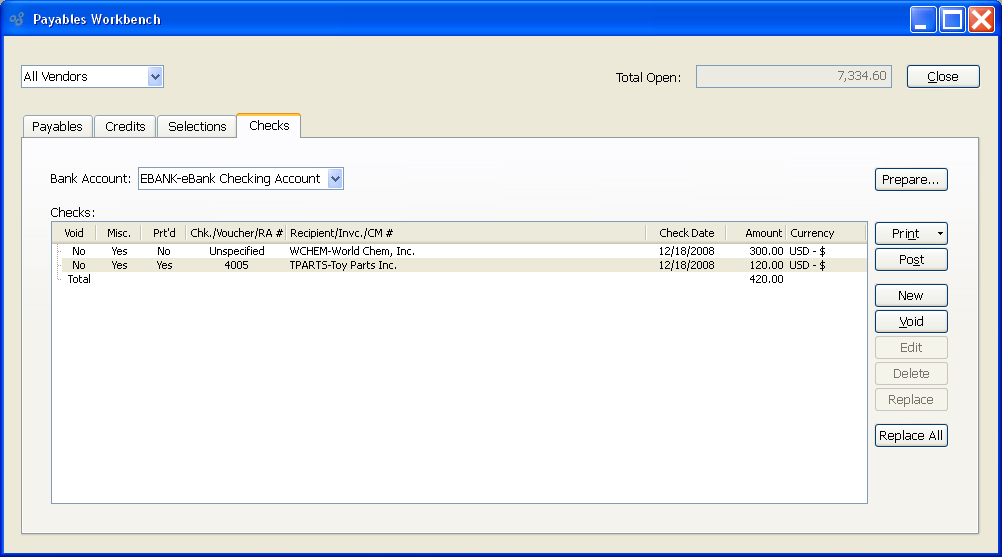
When displaying the Check Run, you are presented with the following options:
- Bank Account
Specify the Bank Account whose Check Run you want to view.
- Checks
Display lists details for Checks included in the Check Run. This display is a nested list, with a plus ("+") sign located to the far left of the display next to each Check. By clicking your mouse on a plus sign, you reveal lower levels of information related to the Check.
To the far right of the screen, the following button is available:
- PREPARE
Select to prepare a Check Run. For more information on preparing Check Runs, see Section 1.4.3, “ Prepare Check Run”.
Select to print a copy of the list displayed on the screen.
- SELECTED CHECK
Highlight a Check in the list of Checks and then select this button to print the Check.
Tip
f Checks being printed contain reference lines which spill over and exceed one standard page, then consider using the report definition CheckMultiPage.xml. This Check Form is designed to support multiple pages for one Check number.
- CHECK RUN
Select to print the Check Run, using the specified Bank Account. For more information on printing Check Runs, see the Section 1.6.3, “ Print Check Run” section.
- EDIT LIST
Provides the option to select printer.
- POST
Highlight a Check in the list of Checks and then select this button to post the Check. A Check must be printed before it can be posted. See the "Printed" column in the display to determine a Check's printed status.
- VOID
Highlight a Check in the list of Checks and then select this button to void the Check. Voided Checks may not be printed or posted. When a Check is voided, the payable amount will be reopened on the Select Payments screen. In other words, if a Check for $100.00 is voided, that amount will once again be made available for payment on the Select Payments screen. The reopened amount will again be associated with the referring payable Document (i.e., Voucher or Debit Memo).
- EDIT
Highlight a miscellaneous Check and then select this button to edit the Check. Only unprinted miscellaneous Checks may be edited.
Note
Only unprinted miscellaneous Checks may be edited. Regular Checks may not be edited.
- DELETE
Highlight a voided Check in the list of Checks and then select this button to delete the Check. Only voided Checks may be deleted.
- REPLACE
Highlight a voided Check in the list of Checks and then select this button to replace the Check. Checks must be voided before they can be replaced. When a voided Check is replaced, the payable amount displayed on the Select Payments screen will be removed. In other words, if a voided Check for $500.00 is replaced, that amount will no longer be available for payment on the Select Payments screen.
- REPLACE ALL
Select this button to replace all Checks shown in the list of Checks. Checks must be voided before they can be replaced.
A/P Forms.
To print a Purchase Order, select the "Print Purchase Order" option. The following screen will appear:
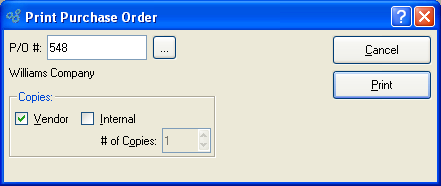
When printing a Purchase Order, you are presented with the following options:
- P/O #
Enter the Purchase Order Number of the Purchase Order you want to print.
- Copies
Indicate the copies you want to print:
- Vendor
Select to print one Vendor copy of the specified Purchase Order.
- Internal
Select to print internal copies of the specified Purchase Order. When you select this option, the "# of Copies" field will be enabled.
- # of Copies
Specify the number of internal copies you want to print.
To the far right of the screen, the following buttons are available:
- CANCEL
Closes the screen, returning you to the application desktop.
Runs the report associated with this screen. If the Vendor specified on the Purchase Order has an EDI Profile attached, you may encounter an EDI processing interface when printing the Purchase Order.
To print an individual Check, select the "Print A/P Check" option. The following screen will appear:

Tip
If Checks being printed contain reference lines which spill over and exceed one standard page, then consider using the report definition CheckMultiPage.xml. This Check Form is designed to support multiple pages for one Check number.
When printing an individual Check, you are presented with the following options:
- Bank Account
Specify the Bank Account for the Check you want to print. If the specified Bank Account is configured to use Automated Clearing House (ACH), the CREATE ACH FILE button will be enabled on this screen.
- Check
Specify the Check Number you want to print. Menu will list Checks from prepared Check Runs associated with the specified Bank Account.
- Next Check #
Specify the next Check number.
To the far right of the screen, the following buttons are available:
- CANCEL
Closes the screen without printing a Check, returning you to the application desktop.
Prints the specified Check.
- CREATE ACH FILE
Select to create an Automated Clearing House (ACH) file. This button will be enabled only for Bank Accounts which are configured to use ACH.
To print a Check Run, select the "Print Check Run" option. The following screen will appear:

Tip
If Checks being printed contain reference lines which spill over and exceed one standard page, then consider using the report definition CheckMultiPage.xml. This Check Form is designed to support multiple pages for one Check number.
When printing a Check Run, you are presented with the following options:
- Bank Account
Specify the Bank Account associated with the Check Run you want to print. If the specified Bank Account is configured to use Automated Clearing House (ACH), the CREATE ACH FILE button will be enabled on this screen.
- First Check #
Displays the first available Check Number in the Check Run for the specified Bank Account.
- # of Checks to Print
Specify how many Checks should be printed in the Check Run. Check Numbers increment in intervals of one (1) beginning with the first Check Number displayed above. The maximum possible selection indicates the maximum number of Checks in the Check Run. Selecting a number less than the maximum will cause that number of Checks to be printed, leaving the remaining number still to be printed.
Note
Checks will automatically print by recipient type (Vendor, Tax Authority, Customer) then alphabetically by the recipients number.
- Order Checks by Name
Select to print Checks in alphabetical order by Vendor, Customer, or Tax Authority name.
To the far right of the screen, the following buttons are available:
- CANCEL
Closes the screen without printing the Check Run, returning you to the application desktop.
Prints the Check Run, using the specified parameters.
- CREATE ACH FILE
Select to create an Automated Clearing House (ACH) file. This button will be enabled only for Bank Accounts which are configured to use ACH.
If for some reason you experience printing problems when printing a Check Run, select the NO button from the following screen:
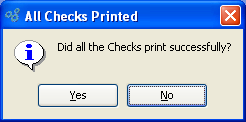
If you select the NO button at the end of printing a Check Run, the following screen will appear:
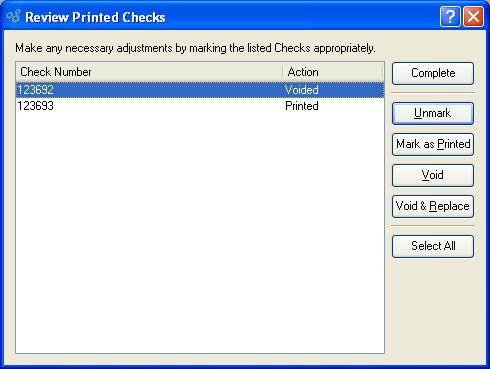
The Review Printed Checks screen lists all the Checks which were included in the Check Run.
Note
The default action listed for all Checks in a Check Run is "Printed." Each Check will be marked as printed when you select the COMPLETE button, unless you specify one of the other possible actions: void, replace, etc.
When reviewing the list of Checks included in a Check Run, you are presented with the following options:
- COMPLETE
Select to perform the specified action associated with each of the listed Checks. This should be the last option selected at the conclusion of your Check Run review. Selecting this option terminates the review process. If no action is specified for a Check, the status of the Check will remain as it was prior to printing the Check Run.
- UNMARK
Highlight a Check Number and then select this option to remove any action associated with the Check. If no action is specified for a Check, the status of the Check will remain as it was prior to printing the Check Run.
Tip
You may select multiple Checks for marking using the SHIFT or CTRL keys and your mouse.
- MARK AS PRINTED
Highlight a Check Number and then select this option to mark the Check as printed. By default, all Checks in a Check Run are marked as printed.
- VOID
Highlight a Check Number and then select this option to mark the Check as voided. Before a Check can be replaced, it must first be voided.
- VOID & REPLACE
Highlight a Check Number and then select this option to mark the Check as voided and then replace the Check with a new Check. Using this option, you can both void and replace a Check in one step.
- SELECT ALL
Use this option to automatically select all Checks for marking, or unmarking.
A/P Reports section.
To view uninvoiced Receipts and Returns, select the "Uninvoiced Receipts and Returns" option. The following screen will appear:
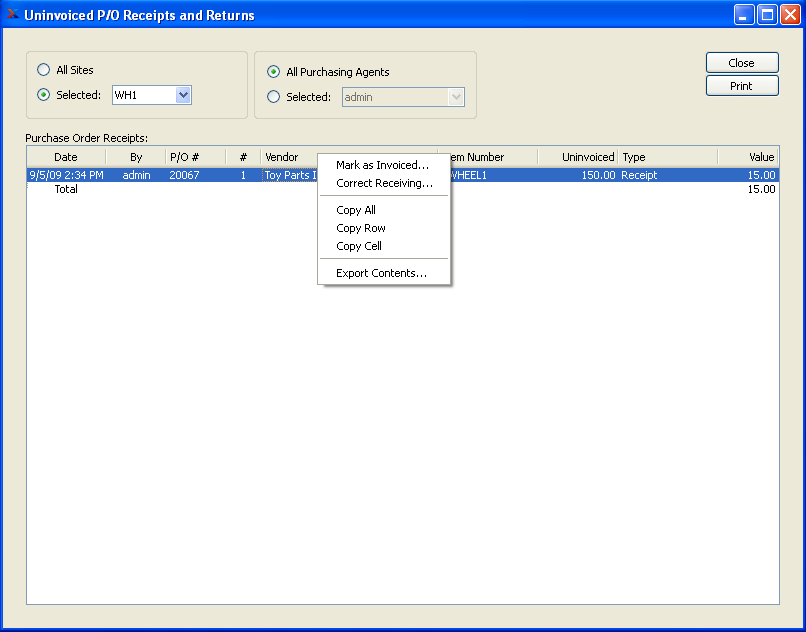
When displaying uninvoiced Receipts and Returns, you are presented with the following options:
- All Sites
Select to display uninvoiced Receipts and Returns for all Sites. You must select this option to include non-Inventory Receipt information in the display. Because non-Inventory Items, by definition, do not have Item Sites, you cannot report on them by individual Site(s).
- Selected
Specify Site whose uninvoiced Receipts and Returns you want to display.
- All Purchasing Agents
Select to display uninvoiced Receipts and Returns for all Purchasing Agents.
- Selected
Specify Purchasing Agent whose uninvoiced Receipts and Returns you want to display. Users may be designated as Purchasing Agents at the system level.
- P/O Receipts
Display lists uninvoiced Receipts and Returns, using the specified parameters.
Tip
The primary path for marking Purchase Order Line Items as invoiced is on the Voucher Item screen. If received (or returned) quantity is tagged as "Yes" on the Voucher Item screen—and the Voucher is then posted—the quantity will no longer appear on the "Uninvoiced Receipts and Returns" screen.
To the far right of the screen, the following buttons are available:
- CLOSE
Closes the screen, returning you to the application desktop.
Runs the report associated with this screen.
To mark a Line Item Receipt as invoiced, highlight the Receipt and then select the "Mark as Invoiced" option from the right-click menu. The following screen will appear:

When marking a Line Item Receipt as invoiced, you are presented with the following options:
- Account
Select the Account you want to use opposite the P/O Liability Clearing Account. When this transaction is posted, the P/O Liability Clearing Account will be debited with the distribution amount—and the Account you specify will be credited. In this way, you will be sure to clear P/O Liability when marking Receipts as invoiced outside of the typical vouchering process flow.
- Amount to Distribute
Displays the Line Item Receipt amount to be distributed to the General Ledger when the transaction is posted.
To the far right of the screen, the following buttons are available:
- CANCEL
Closes the screen without marking the Receipt as invoiced, returning you to the application desktop.
- CORRECT
Select to post the distribution, using the specified Account.
To make corrections to a Purchase Order Receipt, select the "Correct Receiving" option from the right-click menu. The following screen will appear:
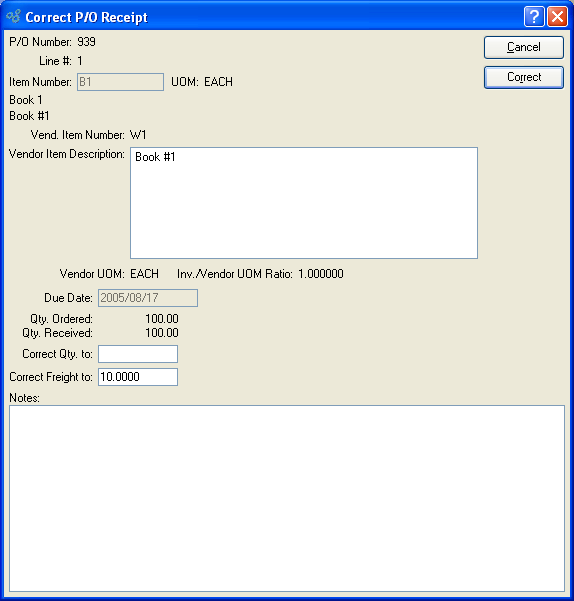
When correcting a Purchase Order Receipt, you are presented with the following options:
- P/O Number
Displays the selected Purchase Order Number.
- Line #
Displays the selected Line Item Number from the specified Purchase Order.
- Item Number
Displays Item Number associated with the specified Line Item Number.
- UOM
Inventory Unit of Measure.
- Vend. Item Number
Displays the Item Number the Vendor uses.
- Vendor Item Description
Displays the description for the Vendor Item Number.
- Vendor UOM
Displays the Unit of Measure the Vendor uses for the specified Item.
- Inventory/Vendor UOM Ratio
/Vendor UOM Ratio: Displays the ratio between Inventory and Vendor Units of Measure.
Note
The Inv./Vendor UOM Ratio specifies the ratio between Inventory and Vendor Units of Measure (UOM). For example, if you store an Item in single units, but a Vendor sells you the Item in cases of 12, then the ratio would be 12—or 12:1. When an Inv./Vend. ratio is specified, the system allows you to purchase Items using the Vendor's UOM; however, when the Items are received, the system will automatically convert the Inventory to your Inventory UOM.
- Due Date
Displays the date when the Line Item is due.
- Qty. Ordered
Displays the original Line Item quantity ordered.
- Qty. Received
Displays the total Line Item quantity received to date.
- Correct Qty. to
Enter the quantity you want to correct the received quantity to. This correction will create adjusting General Ledger entries when the CORRECT button is selected.
- Correct Freight to
Enter the amount you want to correct the Line Item freight to. This correction will create adjusting General Ledger entries when the CORRECT button is selected.
- Notes
This is a scrolling text field with word-wrapping for entering Notes related to the correction.
To the far right of the screen, the following buttons are available:
- CANCEL
Closes the screen without entering a correction, returning you to the application desktop.
- CORRECT
Select to post the correction. This action will result in adjusting General Ledger transactions.
To edit Vouchers that have been created but not yet posted, select the "Vouchering Edit List" option. The following screen will appear:
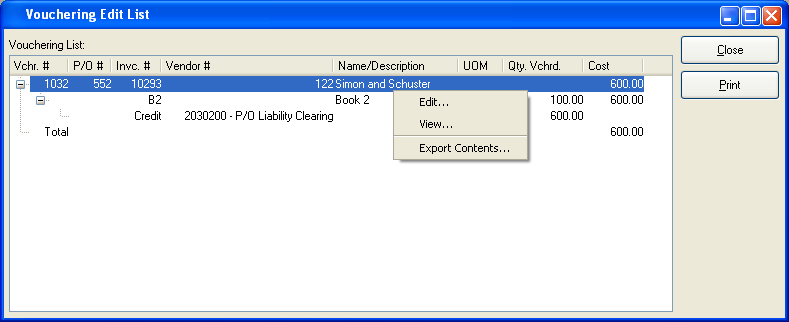
The "Vouchering Edit" screen displays information on all existing Vouchers, including Voucher Number, Purchase Order Number, Vendor number, Vendor name/description, Vendor Item UOM, quantity to Voucher, and Cost. Voucher Line Items and Account distributions will display in a nested manner beneath the associated parent Voucher. Select a plus "+" sign to reveal lower levels of detail. To hide detail, select the minus "-" sign.
To the far right of the screen, the following buttons are available:
- CLOSE
Closes the screen, returning you to the application desktop.
Runs the report associated with this screen.
To view open A/P open items by Vendor, select the "Open Items by Vendor" option. The following screen will appear:
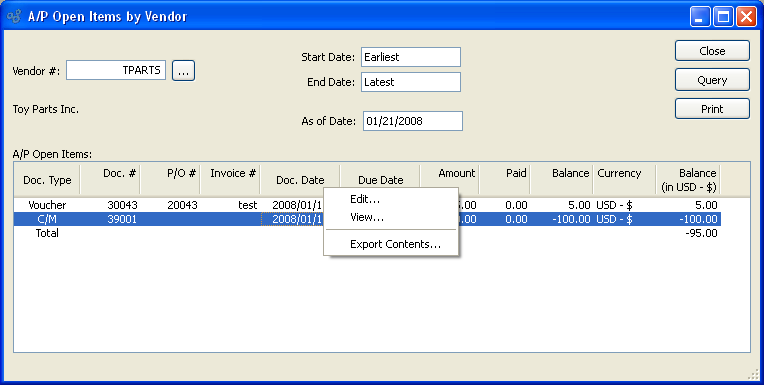
When displaying A/P open items by Vendor, you are presented with the following options:
- Vendor #
Enter the Vendor number of the Vendor whose A/P open items you want to display.
- Start Date
A/P open items for the specified Vendor entered on and after this date will be displayed.
- End Date
A/P open items for the specified Vendor entered on and before this date will be displayed.
- As of Date
Specify the date you want the A/P open items to be relative to. The report will include any A/P items which were open—that is, not yet paid—as of the specified date. This feature provides "point-in-time" open balance functionality.
Note
The payment date used as a reference for the "As of Date" field is the G/L distribution date, not the posting date.
- A/P Open Items
Display lists A/P open items by Vendor, using the specified parameters.
To the far right of the screen, the following buttons are available:
- CLOSE
Closes the screen, returning you to the application desktop.
- QUERY
Select to generate the display, using the specified parameters.
Runs the report associated with this screen.
The A/P Aging report gives you the ability to view A/P open items in a bucketed, time-phased perspective. And this perspective is portable, allowing you to view point-in-time snapshots of open balances.
An open Item is recognized by the A/P Aging report "as of" the item's document or distribution date. In the case of Vouchers, the distribution date is the date the Voucher is distributed to the General Ledger (G/L). (A/P Debit/Credit Memos are distributed to the G/L on their document date.) For example, if you post a Voucher on January 1, but the G/L distribution date is February 15, then the "as of" distribution date for that open item will be February 15 while the doc date will be January 1. This means, if you run the A/P Aging report with an "as of" distribution date in January, the open item distributed to the G/L on February 15 will not appear in the report. In fact, it will not appear in the report until an "as of" date of February 15 or later is specified.
Tip
You can view the document date for an open item by right-clicking on a line in the A/P Aging display. You can also find open item details on other screens—for example, Vendor History, Open Items by Vendor, etc.
The grouping of open items into time-phased buckets is driven by a document's due date. In other words, if a due date falls within 0-30 days of the "as of" date specified when the report is run, then the open item will appear in the first bucket. If the due date falls 31-60 days past the specified "as of" date, then the open item will appear in the second bucket. And so on.
To view Accounts Payable (A/P) open items from an aging perspective, select the "A/P Aging" option. The following screen will appear:
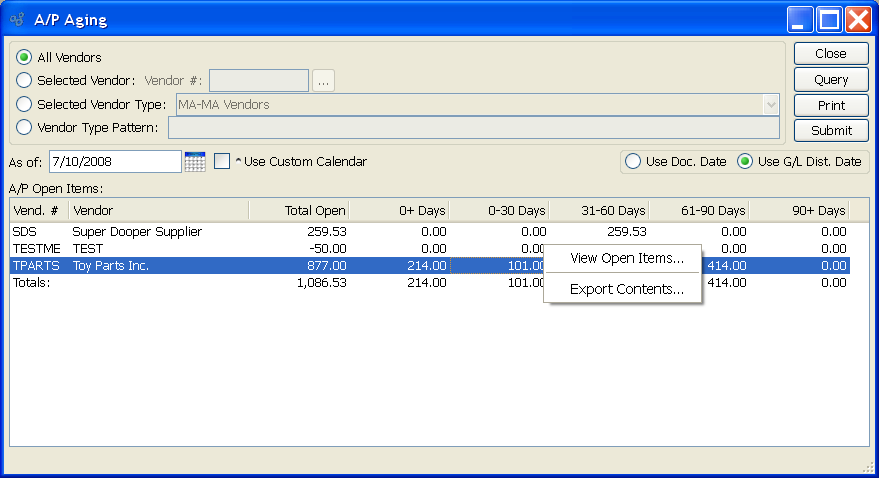
When displaying aging A/P open items, you are presented with the following options:
- All Vendors
Select to display A/P open items for all Vendors.
- Selected Vendor
Select to display A/P open items for a selected Vendor.
- Selected Vendor Type
Specify Vendor Type whose A/P open items you want to display.
- Vendor Type Pattern
Enter a Vendor Type pattern to select a range of Vendor Types. Refine your search using Regular Expressions.
- As of Date
Specify the date you want the A/P open items to be relative to. The report will include any A/P items which were open—that is, not yet paid—as of the specified date. This feature provides "point-in-time" open balance functionality. But again, keep in mind that the document date for an A/P open item (e.g., Voucher distribution date) must be on or before the specified "as of" date for the item to be recognized by the report.
- Use Custom Calendar
Select if you want to display A/P open items using a custom Calendar of your choosing. If selected, the screen will present a series of different options, including the option to select a Calendar and associated periods.
- Use Doc. Date
Select if you want to display A/P open items relative to the Document sate.
- Use G/L Dist. Date
Select if you want to display A/P open items relative to the G/L distribution date.
- A/P Open Items
Display lists aging A/P open items, using the specified parameters.
To view A/P open items using a custom Calendar, select the "Use Custom Calendar" option above. The following screen will appear:
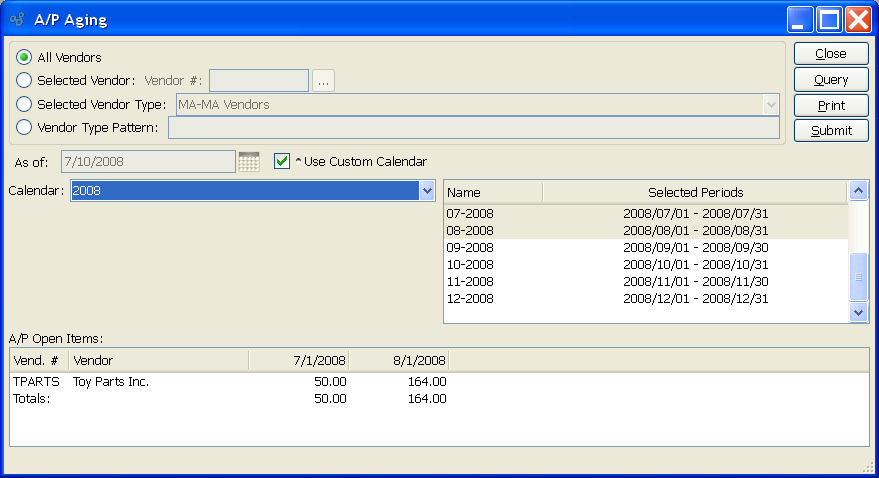
When displaying A/P open items using a custom Calendar, you are presented with the following options:
- Calendar
Select the Calendar you want to use for the report. Associated Calendar periods will be displayed.
- Name/Selected Periods
Select as many periods as you want to display. Selected periods correspond to Calendar specified in the "Calendar" field. Select individual periods or groups of periods together. To select an individual period, highlight the period using your mouse button. The period is now selected. To select a sequence of periods, highlight the first in the sequence using your mouse button. Then, holding down the SHIFT key on your keyboard, highlight the last period in the sequence. The entire sequence is now selected. To select periods that are out of sequence (e.g., January, April, July, October), highlight the first period in the group. Then, holding down the CTRL key on your keyboard, highlight the next period you want to select. Continue highlighting periods with the CTRL key depressed until all desired periods are selected. The entire group is now selected.
- A/P Open Items
Display lists time-phased A/P open items, using the specified parameters.
To the far right of the screen, the following buttons are available:
- CLOSE
Closes the screen, returning you to the application desktop.
- QUERY
Select to generate the display, using the specified parameters.
Runs the report associated with this screen.
- SUBMIT
Select to submit report to the Batch Manager.
To view Check Registers by Bank Account, select the "Check Register" option. The following screen will appear:
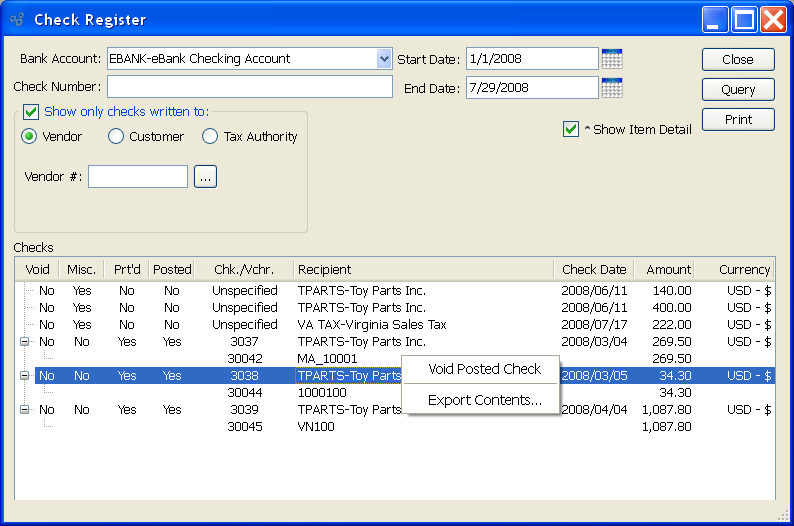
Tip
You can void posted Checks using the right-click option on the Check Register display. When voiding a Check, you will be given the option to specify the void date. Apply-to records will also be reversed on the void date you specify.
When displaying Check Register information, you are presented with the following options:
- Bank Account
Specify the Bank Account whose Check Register information you want to display.
- Check Number
Enter a Check Number or Regular Expression. The display will show Check(s) matching the specified Check Number(s).
- Show only checks written to:
Select if you want to limit the results to any of the following Check recipient types:
- Vendor
Select to include only Checks written to Vendors in the report.
- Customer
Select to include only Checks written to Customers in the report.
- Tax Authority
Select to include only Checks written to Tax Authorities in the report.
- Start Date
Checks posted on and after this date will be displayed.
- End Date
Checks posted on and before this date will be displayed.
- Show Item Detail
Select to include Check detail information in the display. If selected, the Vouchers and/or Debit Memos associated with Checks will be displayed in a nested list. Be sure to use the QUERY button after selecting this option to ensure detail is included in the display.
- Checks
Display lists Checks by Bank Account, using the specified parameters. This display is a nested list, with a plus ("+") sign located to the far left of the display next to each date. By clicking your mouse on a plus sign, you reveal lower levels of information related to transactions on that date. The total amount of all Checks will also be displayed.
To the far right of the screen, the following buttons are available:
- CLOSE
Closes the screen, returning you to the application desktop.
- QUERY
Select to generate the display, using the specified parameters.
Runs the report associated with this screen.
To view the register of Voucher transactions, select the "Voucher Register" option. The following screen will appear:
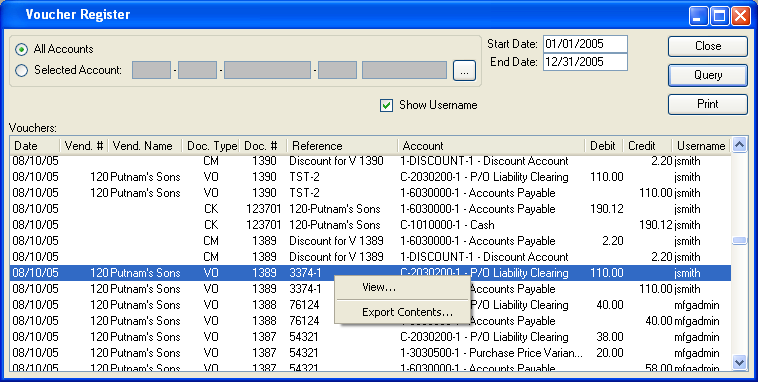
Tip
If you need to void a posted Voucher, you can do this from the right-click menu on the Vendor history screen. When a Voucher is voided, it reverses all the G/L transactions created by the original Voucher.
When displaying the Voucher Register, you are presented with the following options:
- All Accounts
Select to display Voucher transactions for all G/L Accounts.
- Selected Account
Specify G/L Account whose Voucher transactions you want to display.
- Start Date
Vouchers posted on and after this date will be displayed. This is a required field.
- End Date
Vouchers posted on and before this date will be displayed. This is a required field.
- Vouchers
Display lists Voucher transactions based on the specified parameters. The totals for the included transactions will appear at the bottom of the screen.
- Show Username
Select to display the username of users associated with transactions.
To the far right of the screen, the following buttons are available:
- CLOSE
Closes the screen, returning you to the application desktop.
- QUERY
Select to generate the display, using the specified parameters. Start date and end date must be entered for request to proceed. Results will be displayed in the "Vouchers" list.
Runs the report associated with this screen.
To view details concerning the application of Checks and Credit Memos to A/P open items, select the "A/P Applications" option. The following screen will appear:

When viewing A/P application details, you are presented with the following options:
- Vendor
Select all or specific Vendors whose A/P Applications you would like to view.
- Start Date
A/P applications made on and after this date will be displayed.
- End Date
A/P applications made on and before this date will be displayed.
- Show Checks
Select to display only Check application details.
- Show Credit Memos
Select to display only Credit Memo application details.
- Accounts Payable Applications
Display lists A/P application details, using the specified parameters. The amount of each A/P Application is displayed in the document's Currency. The total amount of all applications during the period will display, normalized to the Base Currency using the Currency Exchange Rate effective on the document's Posting Date, at the bottom of the screen.
To the far right of the screen, the following buttons are available:
- CLOSE
Closes the screen, returning you to the application desktop.
- QUERY
Select to generate the display, using the specified parameters.
Runs the report associated with this screen.
The Vendor history screen allows you to view transaction history with individual Vendors. It also provides you the opportunity to void posted Vouchers. To view Vendor history, select the "Vendor History" option. The following screen will appear:
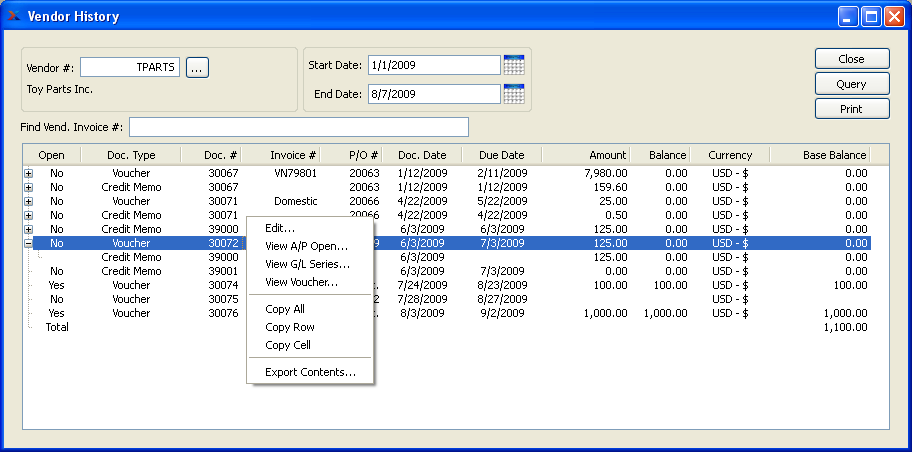
Tip
If you need to void a posted Voucher, you can do this from the right-click menu on the Vendor history screen. When a Voucher is voided, it reverses all the G/L transactions created by the original Voucher. Keep in mind, you may only void open Vouchers―that is, Vouchers which have not yet been fully paid.
When displaying Vendor history, you are presented with the following options:
- Vendor #
Enter the Vendor number of the Vendor whose history you want to display.
- Find Vend. Invoice#
To search for an Invoice in the Vendor History display, begin typing an Invoice Number into this field. As you type, the list will automatically scroll toward the Invoice Number you are typing. You can also search for Invoices manually by scrolling through the list.
- Start Date
Vendor activity entered on and after this date will be displayed.
- End Date
Vendor activity entered on and before this date will be displayed.
- Vendor History
Display lists Vendor history, using the specified parameters. This display is a nested list, with a plus ("+") sign located to the far left of the display next to each Document That may be expanded to lower levels. By clicking your mouse on a plus sign, you reveal lower levels of information related to the Document.
To the far right of the screen, the following buttons are available:
- CLOSE
Closes the screen, returning you to the application desktop.
- QUERY
Select to generate the display, using the specified parameters.
Runs the report associated with this screen.
When posting Vouchers in batch mode, you are given the option to print a Payables Journal. To print a Payables Journal, select the "Payables Journal" option. The following screen will appear:

When printing a Payables Journal, you are presented with the following options:
- Journal Number
Specify the number of the Payables Journal you want to print. Payables Journals are created when Vouchers are posted. The Journal Number you select will include both the Payable Journal Number and also the date when the Vouchers were posted.
To the far right of the screen, the following buttons are available:
- CANCEL
Closes the screen without printing a Payables Journal, returning you to the application desktop.
Runs the report associated with this screen.
When posting A/P Checks in batch mode, you are given the option to print a Check Journal. To print a Check Journal, select the "Check Journal" option. The following screen will appear:

When printing or reprinting a Check Journal, you are presented with the following options:
- Journal Number
Specify the number of the Check Journal you want to print. Check Journals are created when A/P Checks are posted. The Journal Number you select will include both the Check Journal Number and also the date when the Checks were posted.
To the far right of the screen, the following buttons are available:
- CANCEL
Closes the screen without printing a Check Journal, returning you to the application desktop.
Runs the report associated with this screen.
To access the master list of Vendors, select the "Vendors" option. The following screen will appear:
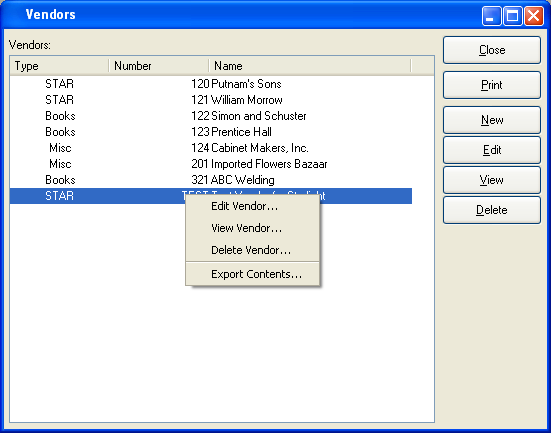
The "Vendors" screen displays information on all existing Vendors, including Vendor Type, Vendor Number, and Vendor name.
To the far right of the screen, the following buttons are available:
- CLOSE
Closes the screen, returning you to the application desktop.
Runs the report associated with this screen.
- NEW
Opens screen for creating a new Vendor.
- EDIT
Enables you to edit highlighted Vendor. The edit screen is the same as that for creating a new Vendor—except that when editing, the fields will contain Vendor information. Double-clicking on a Vendor will also bring you to the editing screen.
- VIEW
Highlight a Vendor and then select this button to reach a read-only view of the "Edit" screen.
- DELETE
Highlight a Vendor and then select this button to remove the Vendor from the list.